Nature in design is a trend that has gained momentum and continued in 2019.
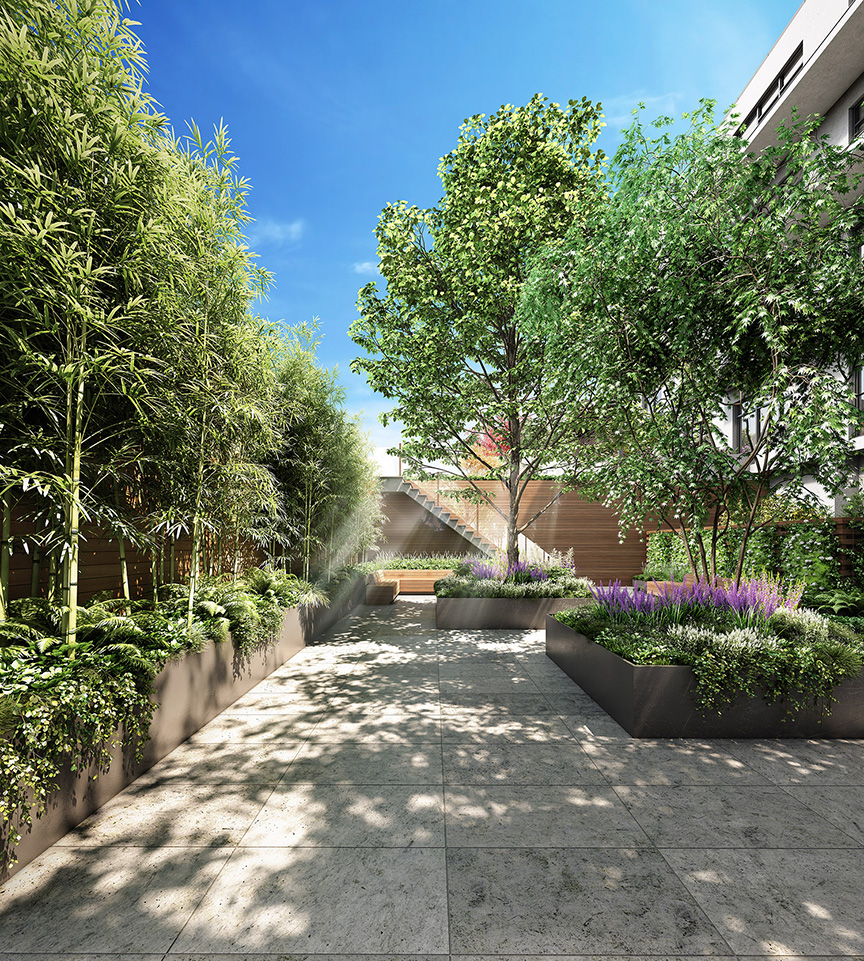
Photo courtesy of Arbor Eighteen
Finding a connection to nature may feel like an impossible task if you’re living in the city or simply lacking the space for a yard. Crowded parks and potted plants may not be the dose of nature that you are seeking. Thankfully, designers and architectures alike are taking the need for nature into consideration and incorporating green into designs and architecture — a trend that is growing in popularity. Blur the line between inside and out with these trends!
Walls of Greenery
The seamless transition between the inside and outside could make the city feel miles away. One way to make that connection is with walls of greenery and other plants, which can freshen and brighten a space. This type of addition can also soften a room that may be surrounded by concrete buildings and bustling sidewalks.
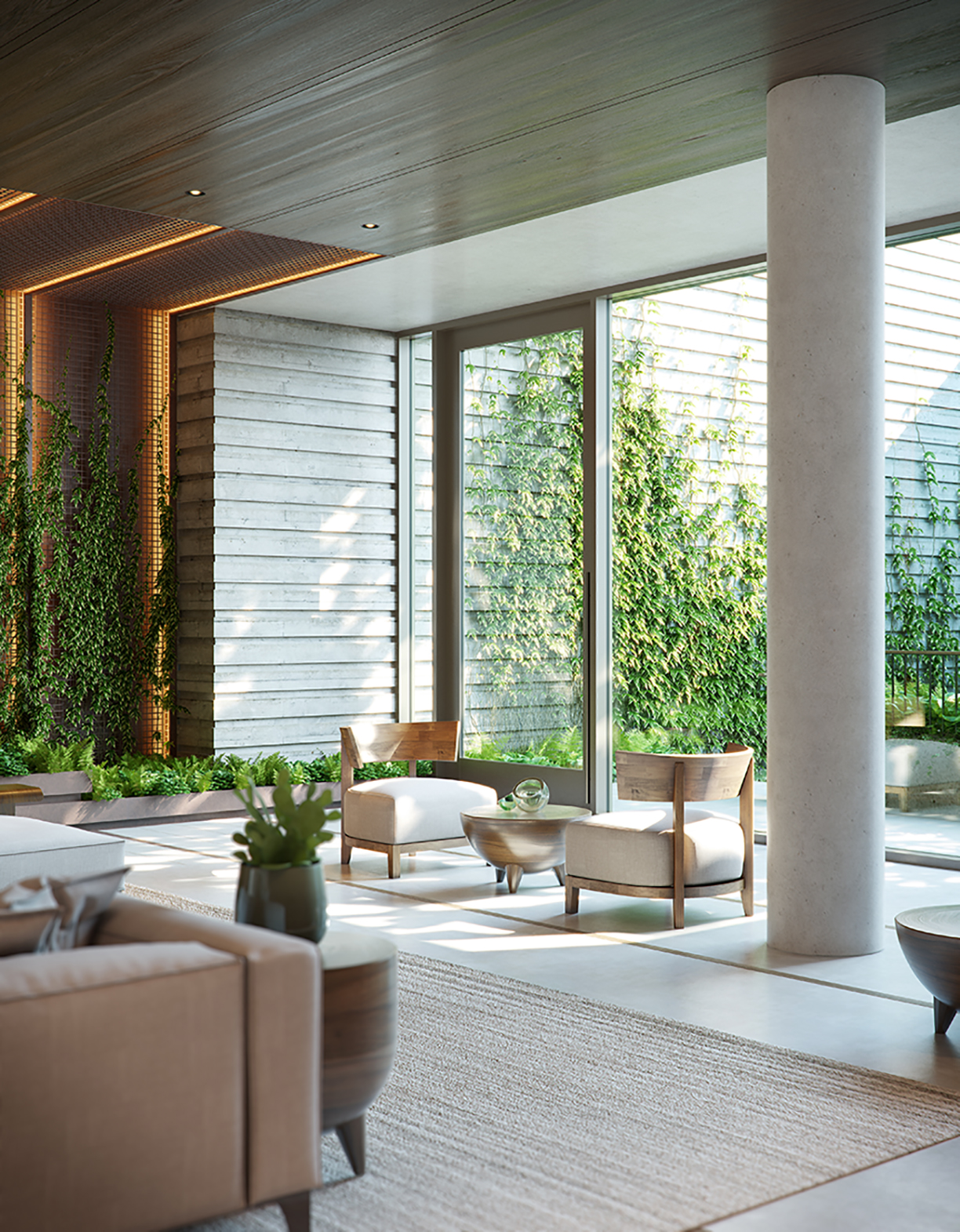
Photo courtesy of 561 Pacific
Designated Outdoor Space
City living can create a high demand for outdoor space that is tranquil and also functional. Designers are embracing the idea of green space that is outdoors and accessible. A common space that has a park-like feel has become a popular trend. The addition of natural elements brings a calming quality to an area.
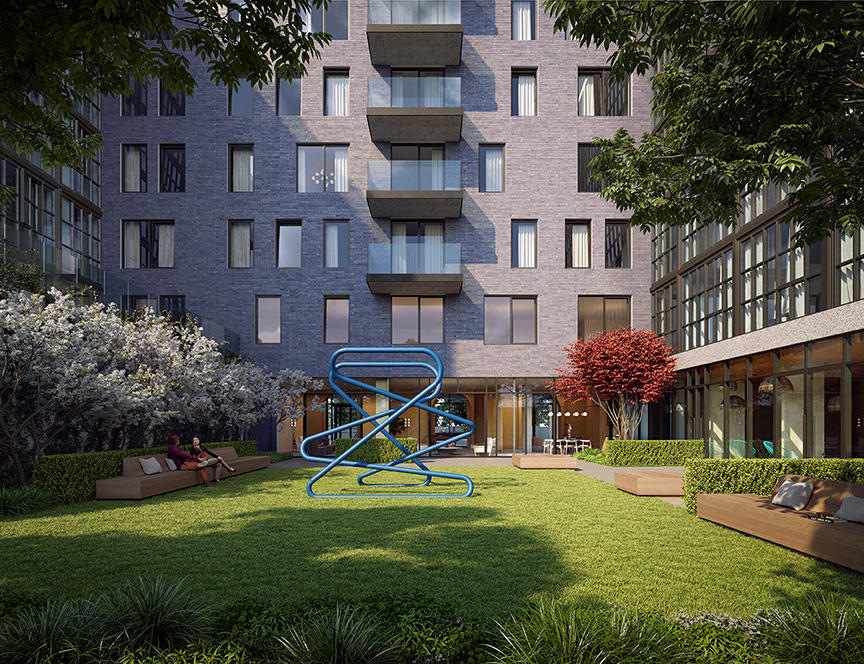
Photo courtesy of Galerie
Nature by the Poolside
Pools and spas are not an uncommon amenity for developments and resorts. However, designers and architectures are incorporating nature, such as native plants into luxury pool and spa areas to give them a softer touch. Rather than surrounding the pool with umbrellas and other structures, a few palm trees give a much more relaxed feel.
Glimpse the Outdoors
If you are lucky enough to have your own outdoor space, floor-to-ceiling windows are a way to bring the outside into your living area. Even a distant view of nature can transform the feel of your home. Walls of windows not only reveal the outdoor environment making it feel within reach but it also allows for plenty of natural light to find its way inside.
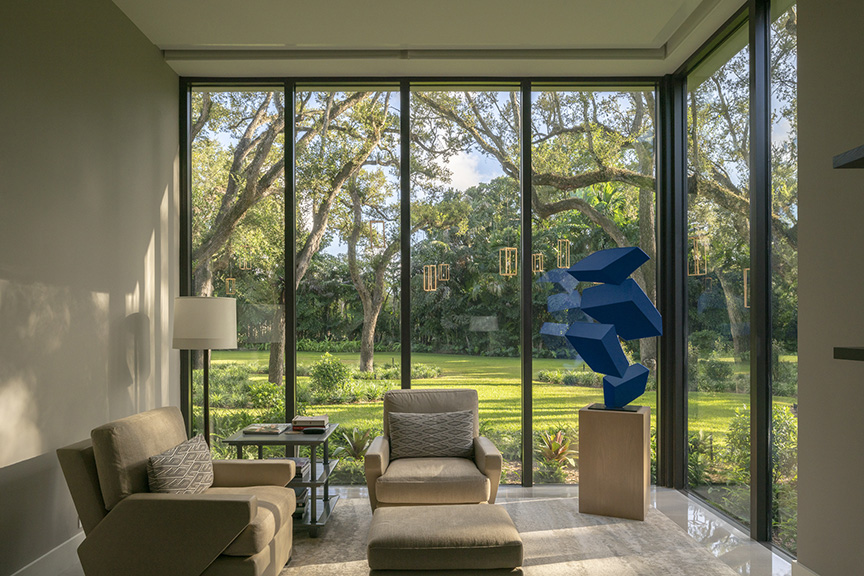
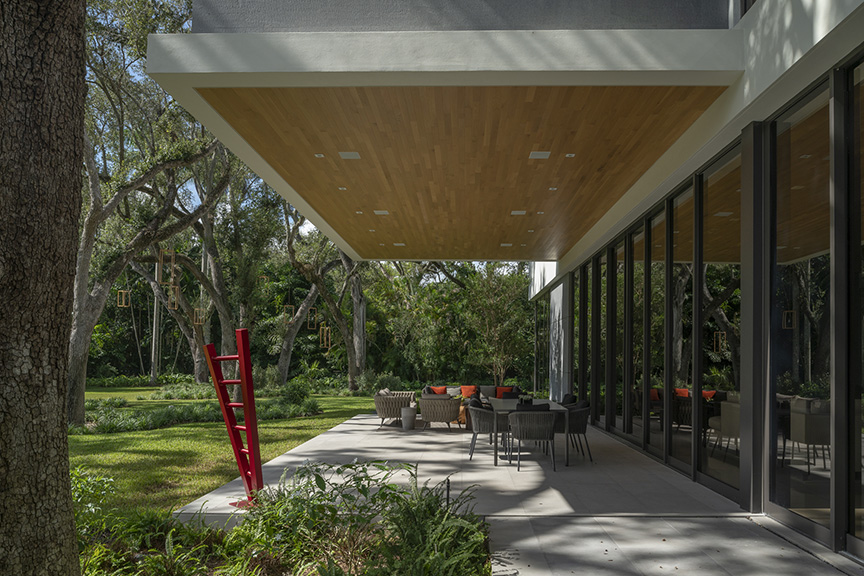
Photos courtesy of Touzet Studio
NYC projects represented by Halstead Property Development Marketing
Let delicate hues of pink, contrasting deep blues against calm gray, and relaxing greens glazes don your dinner table instead of standard dinnerware.
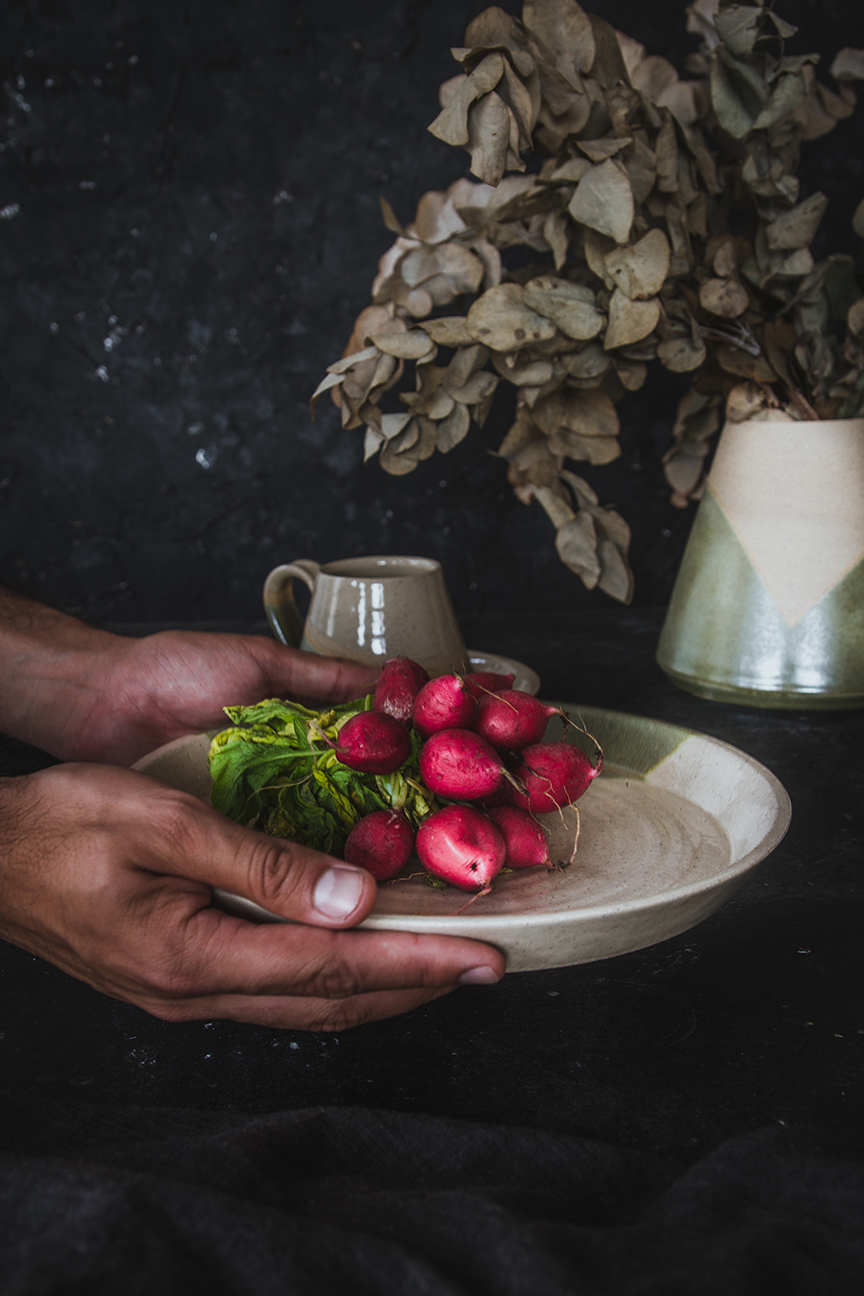
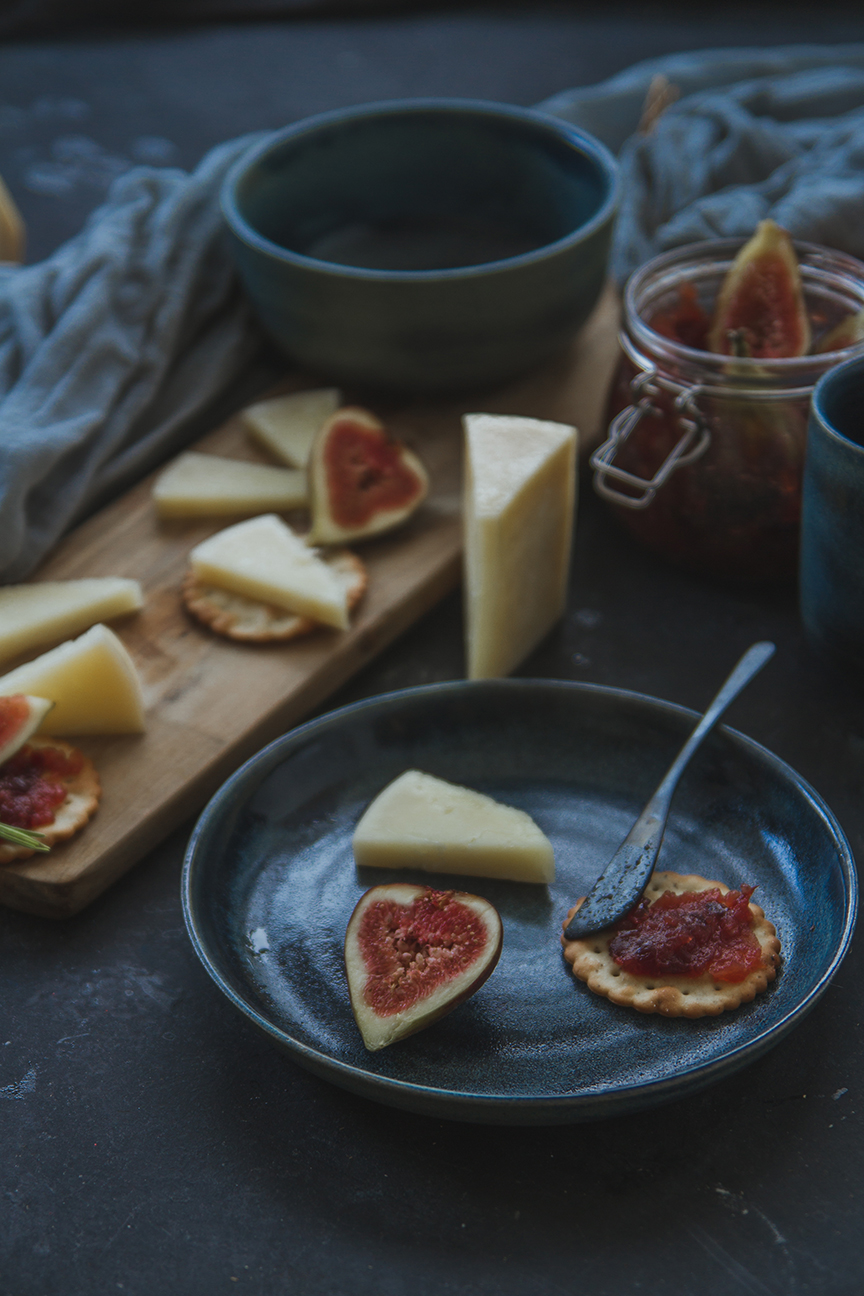
Photography by ‘The Cooking Lab’ – Grey Suit Clay
Small ceramic studios are making an impact with fun designs and a distinct unique feeling for each table. Studios such as Julie Spako’s,Grey Suit Clay, andSkandiHus in London are attracting buyers who crave handmade items you won’t find in bulk. The notion that each dish, bowl, mug or plate is one-of-a-kind makes every purchase feel personal.
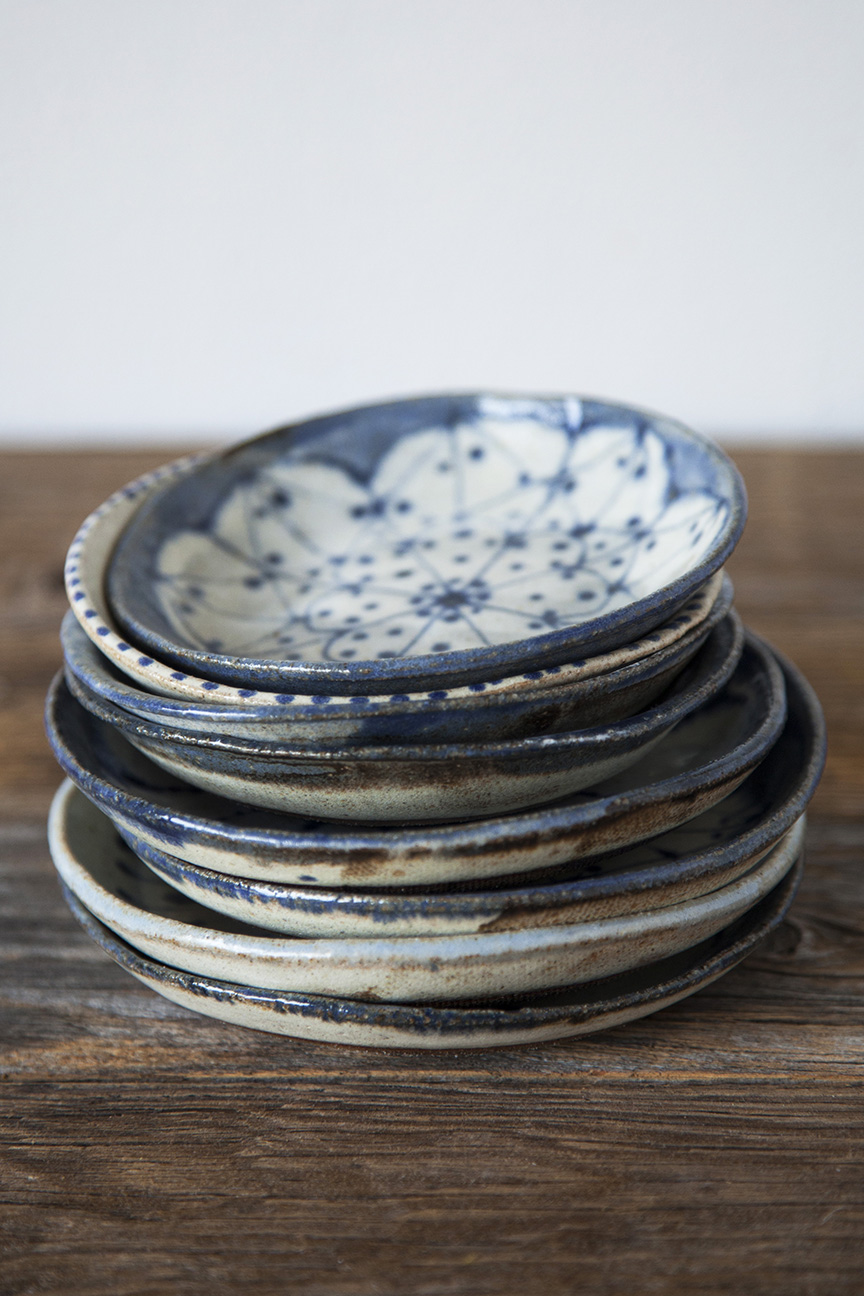
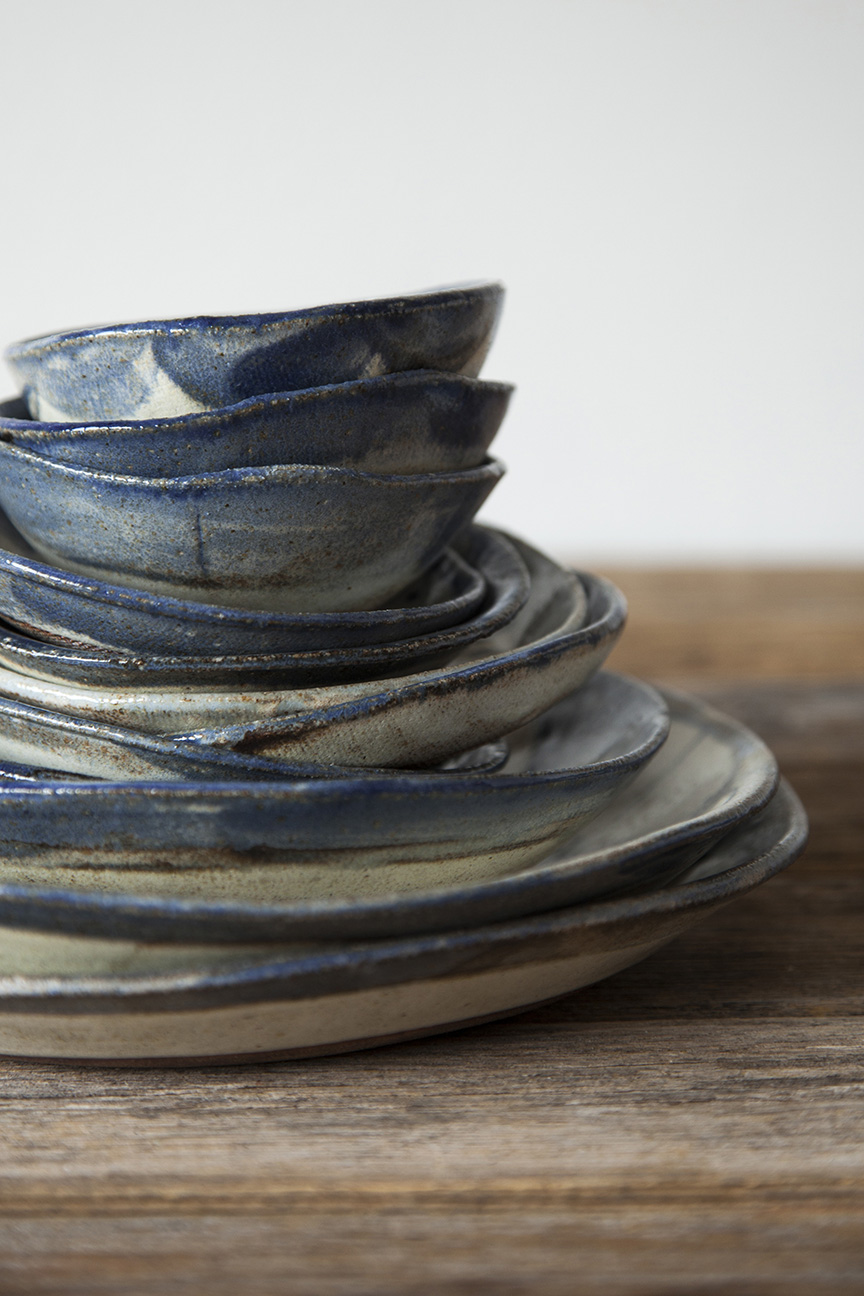
Photos by Pauline Stevens – Julie Spako
Adding handmade ceramics to your table can subtly transform a room with the creativity that comes with singular pieces. Julie Spako, who works expertly with high fire porcelain and stoneware, says “ceramic is both an ancient material and a modern one … It’s an amazing material that will outlive its maker by thousands of years but comes into being by an artist or craftsperson.” Each piece holds its own history, which brings life to any table.
These ceramic creations serve as art, but they’re also functional. “I do consider the function of my pieces as I make them, and I look forward to seeing how they are used. Some of my serving pieces are kept on the kitchen counter as catch-alls from tea bags to coffee-making supplies or in the bathroom to hold wash clothes,” says Spako.
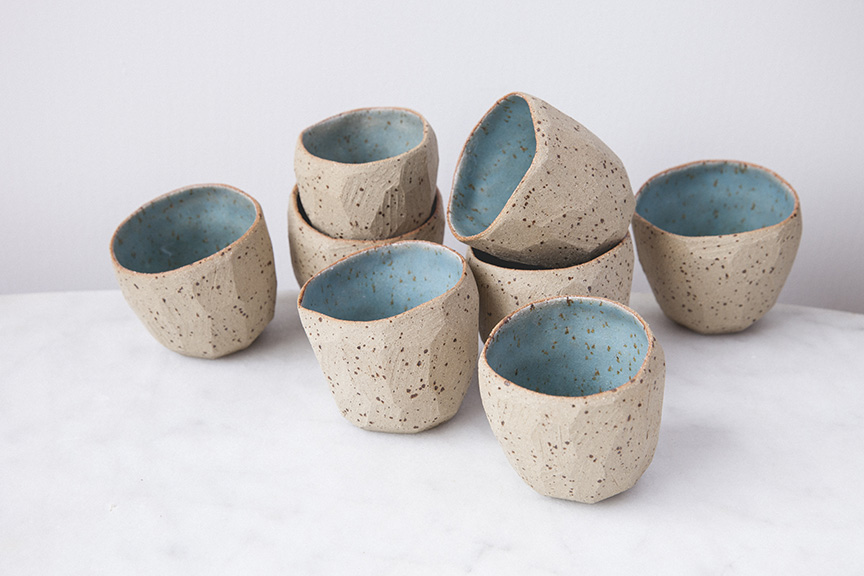

Photos by Charlie Mckay – SkandiHus
Francesca Hague, creator and owner of Grey Suit Clay also carefully considers function during the process, “I always create my pieces with the full intention of them being well used and well loved. I want them to be tactile and ergonomically pleasing in the hand whilst also showcasing a beautiful palette that works to compliment both the table it sits on as well as the food served upon it.”
Each piece is individually made and no plate, bowl, or dish is exactly the same. “Ceramic pieces are very unique in their process and finish. Being handled and molded directly from soft earth into durable, functional work — the potential for such a huge range of styles and finishes is endless,” according to Hague.
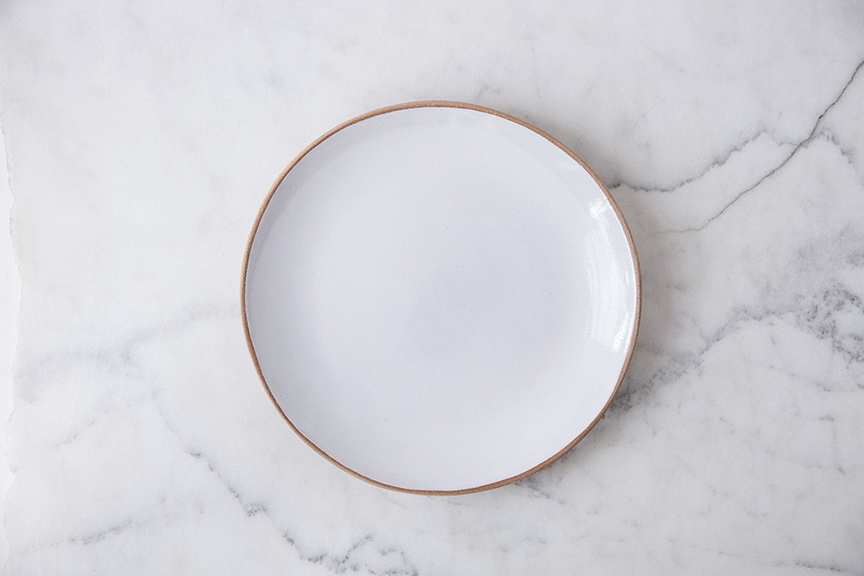
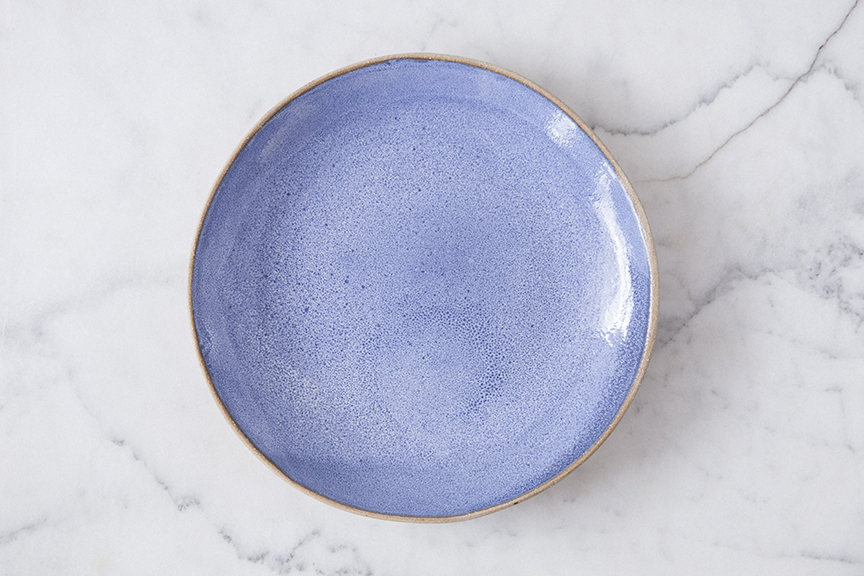
Photos by Charlie Mckay – SkandiHus
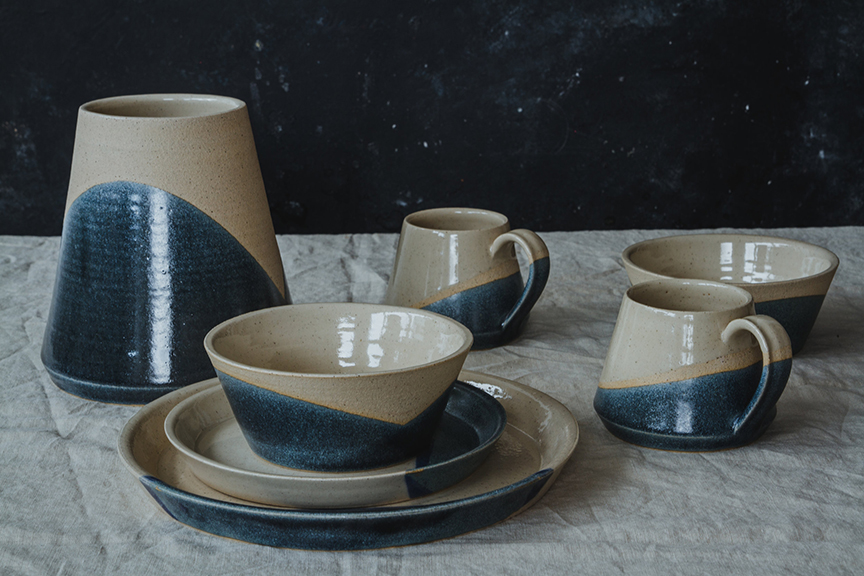
Photography by ‘The Cooking Lab’ – Grey Suit Clay
Elements of city life are slowly making their way into the rustic aesthetics of countryside homes. The modern farmhouse is no stranger to industrial-inspired pieces, which offer a similar back-to-basics look to their brightly colored, agrarian-inspired counterparts. While maintaining the informality and simplicity of classic farmhouse design, an emphasis on industrial furniture and decor adds an unexpected layer of sophistication to rural interiors.
Urban-inspired pieces do not clash with typical farmhouse decor as some may fear. Both industrial and classic country looks share an affinity for woods as the star for nearly every piece of furniture and neat, yet unpolished metals that complement the natural wood. Bringing industrial pieces into the modern farmhouse blends two seemingly opposite aesthetics into a synergistic, chic design.
Here are three industrial-inspired pieces that fit seamlessly into any farmhouse.
Kohler Farmstead Kitchen Sink
$3,150
This 45-inch long sink can be installed wall-mount with legs or top-mount with custom cabinetry. Made from Kohler Enameled Cast Iron, this durable sink is generously proportioned to accommodate large cooking ware. Included in the list price are seven accessories, including a walnut cutting board, a utility rack with a soaking cup and a towel bar.
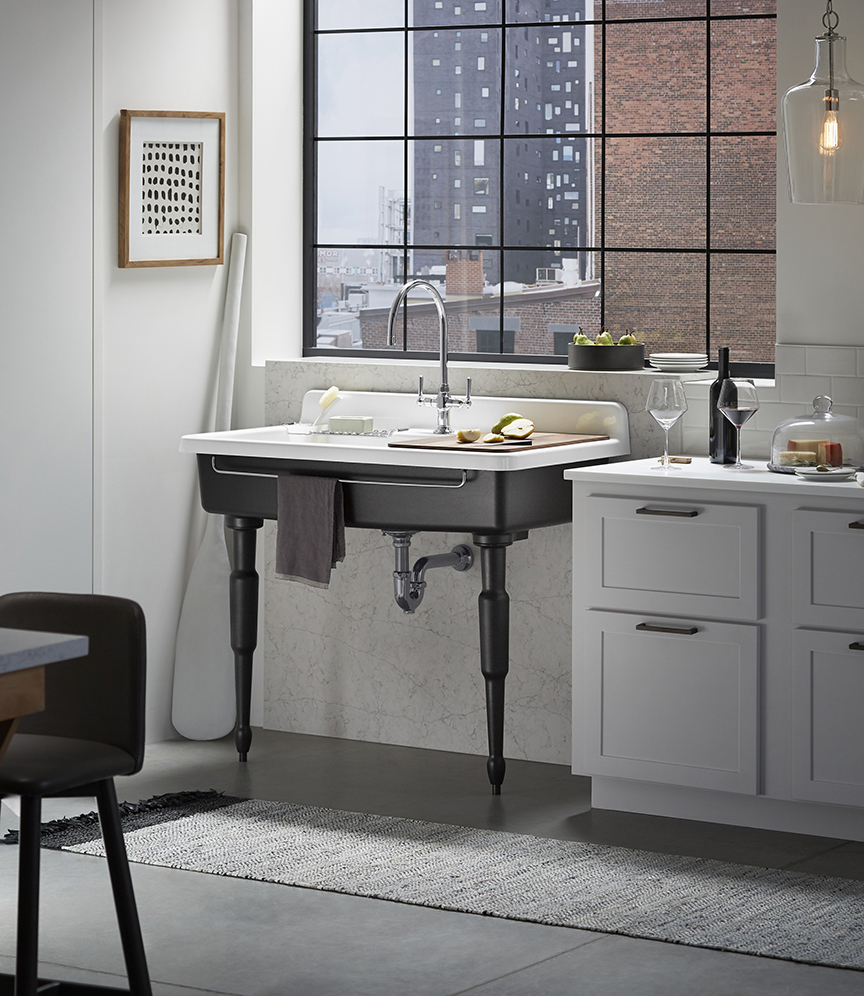
Photo courtesy of Kohler.
Industrial Farmhouse Wavy Glass Island Chandelier by Shades of Light
$799
Perfect to hang over a large dining table, this industrial-inspired chandelier borrows themes from classic farmhouse design with a minimalist wood base. Vintage light bulbs accentuate the piece’s timeless simplicity.
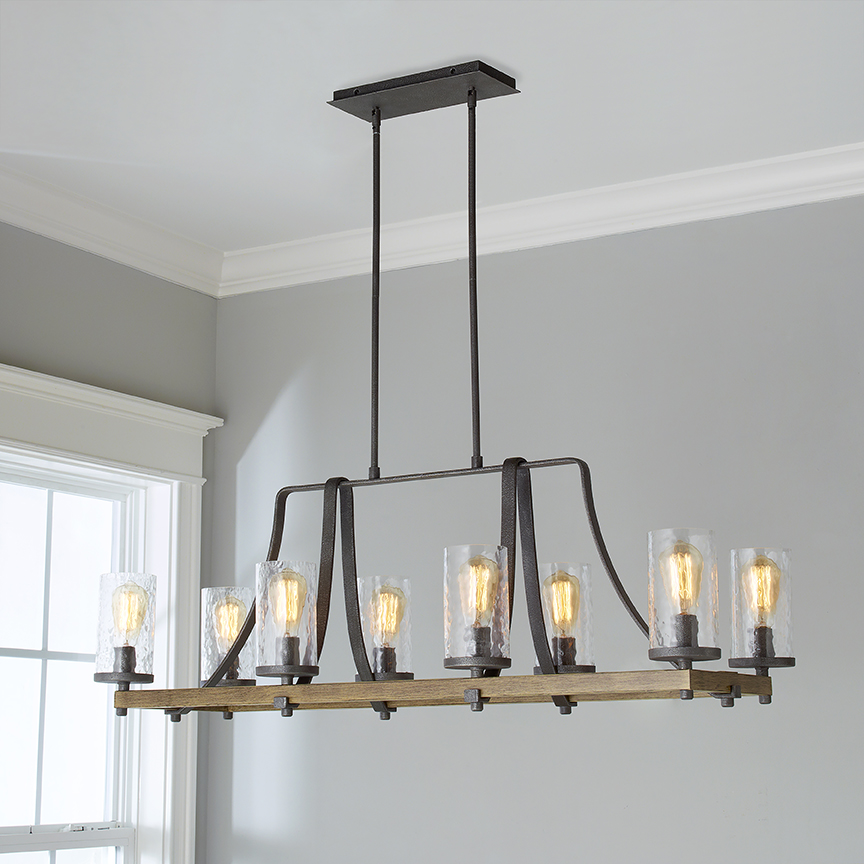
Photo courtesy of Shades of Light.
Farmhouse Industrial Modern Windmill Style Bookshelf by Woodwaves
$425
This unconventional bookshelf offers ample storage space for a living room or office, and the iron windmill atop the unique structure makes it shine as a statement piece. Serving as both a quirky accent item and a functional piece of furniture, this bookshelf is the perfect eye-catching addition to any farmhouse.
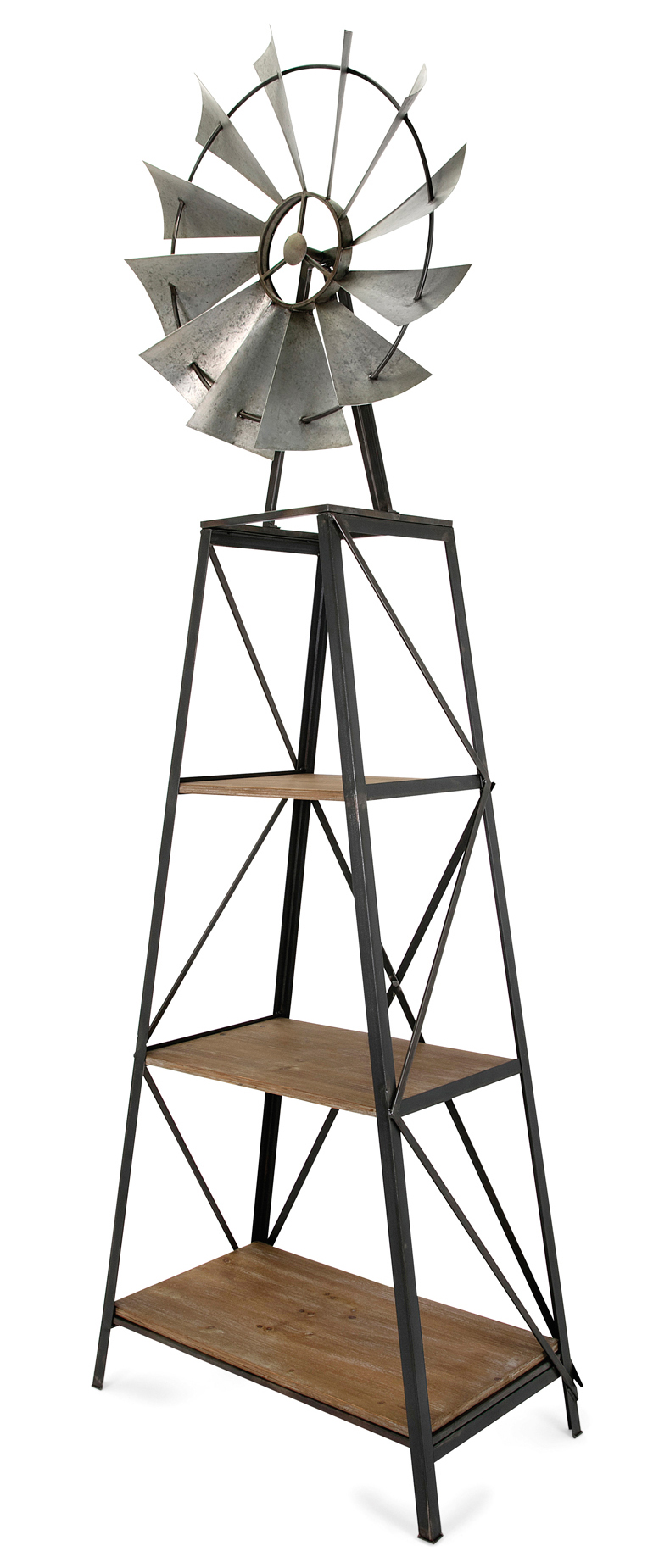
Photo courtesy of Woodwaves.
Increasingly, custom aquariums are amenities in demand by luxury homeowners, pushing specialists to create spectacular showcases.
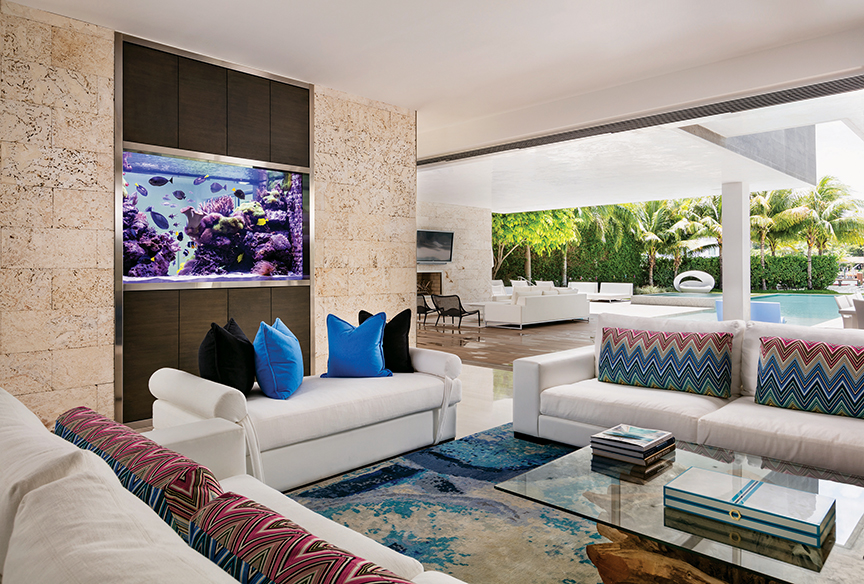
Photo © 2016 Nickolas Sargent All Rights Reserved
Observing decorative tropical fish shimmering through an artificial aquatic habitat can be mesmerizing, but new innovations and elaborate designs have made aquarium industry specialists an essential resource for luxury residential design. A new breed of aquarists is using unbridled imagination and advanced technologies to create larger and more audacious tanks for the home.
Reality television series like Tanked on Animal Planet and Fish Tank Kings on Nat Geo Wild introduce viewers to the incredible possibilities of aquarium design, resulting in focal points that can transform a room into a magical space. High-end aquarists can now be found in every major city and ambitious tanks can be engineered for virtually any residential environment.
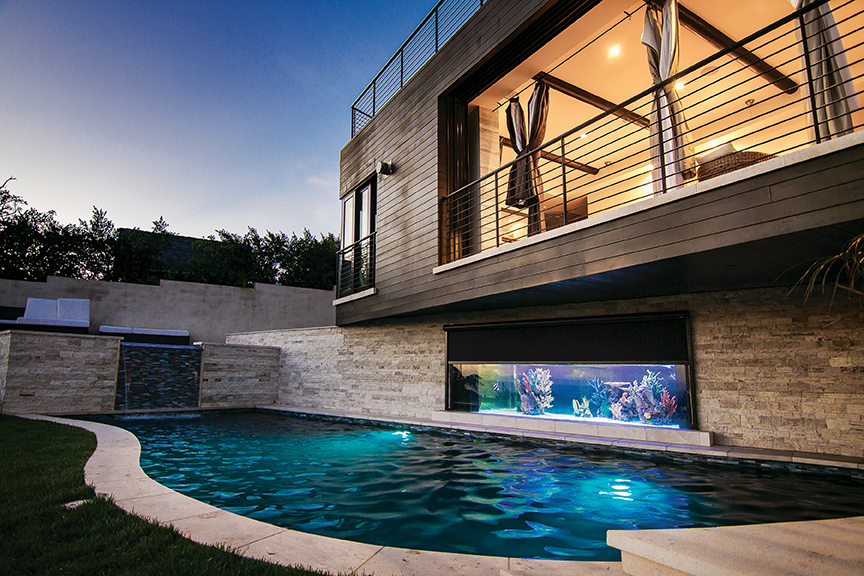
Photo courtesy of Infinity Aquarium Design
Nic Tiemens, co-founder of Los Angeles-based Infinity Aquarium Design, reports, “The installations we’re doing today in high-end residences are more elaborate, both aesthetically and functionally, than those in most public aquariums.” Tiemens’ first taste of the business, as a young minimum-wage employee in Chicago, was the installation of two massive tanks at NBA superstar Michael Jordan’s house. When he and his business partner founded Infinity in 2004, they viewed L.A. as a natural home base, and the firm was featured on HGTV’s Ultimate Aquariums, one of the public’s earliest glimpses into this intriguing specialty. “We’ve branded ourselves as the firm where creativity meets the science of aquariums,” explains the passionate entrepreneur.
Tiemens suggests that homeowners’ increased reliance on interior designers has boosted the residential aquarium business, as those ambitious professionals are constantly looking to enhance spaces with unique water features. Celebrity-favored L.A. interior designer Adam Hunter, who collaborates with Infinity in his luxury residential practice, reports, “Aquariums offer such dramatic appeal to any interior because they can instantly become a beautiful focal point, art piece or topic of conversation.”
Hunter believes aquariums work equally well in both traditional and modern architectural contexts, and the endless options of aquatic environments and species allow designers and aquarists to accommodate virtually any situation. “When you spend hundreds of hours paying attention to every last detail that makes an interior perfect, having an organic, living backdrop provides the ideal contrast to such a structured and scrutinized design,” he explains.
Double-sided tanks are popular and at a Hawaiian-inspired Malibu retreat, Infinity completed a stunning indoor-outdoor poolside aquarium. “From the basement, you can look through the aquarium into the swimming pool, beyond the bluff and out into the ocean,” Tiemens explains of the $80,000 project.
Although nearly 90 percent of the company’s projects are saltwater tanks, Tiemens has observed a sharp uptick in requests for live plant freshwater aquariums as clients become more conscious of sustainability. The company recently completed the largest freshwater planted aquarium in a private U.S. residence for a homeowner aspiring to recreate the work of renowned Japanese aquarist and photographer Takashi Amano.
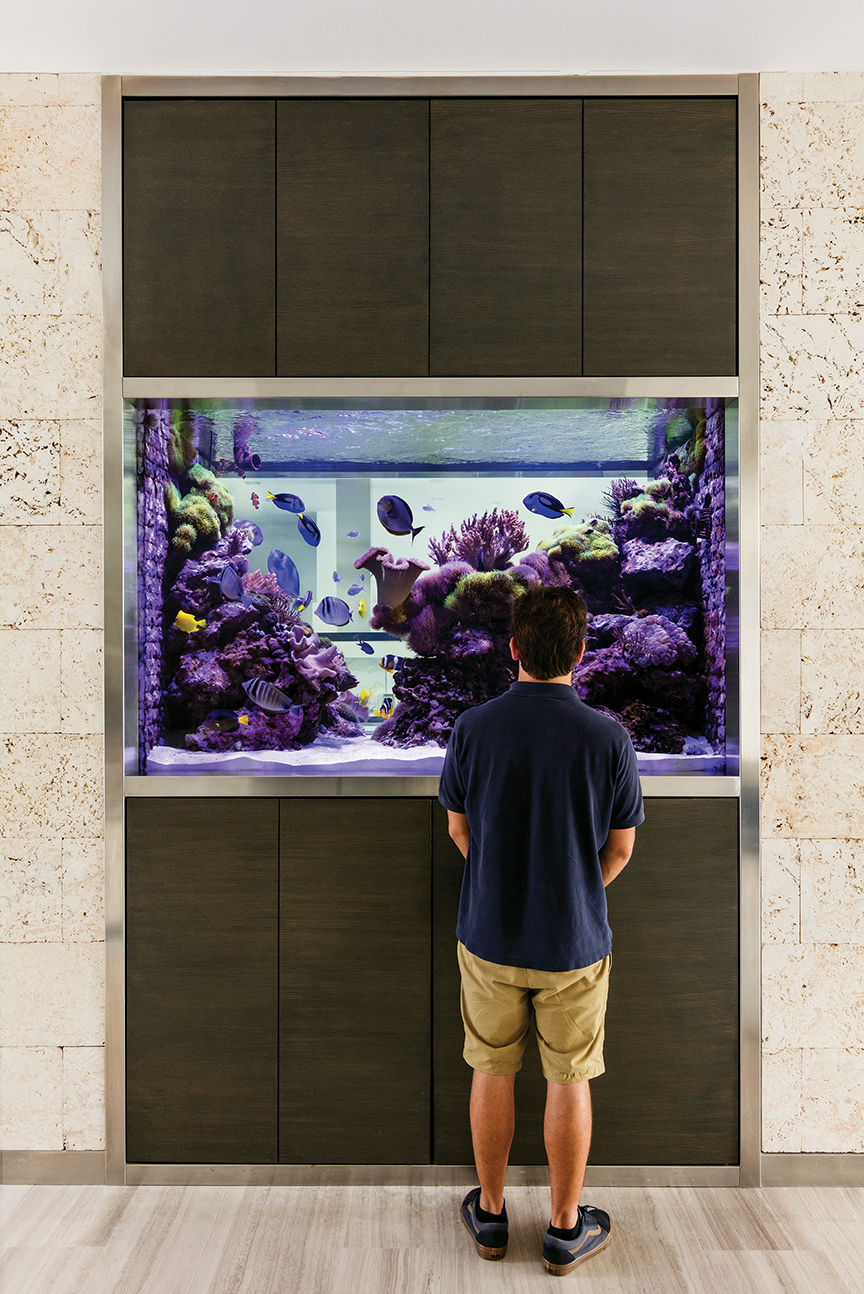
Photo © 2016 Nickolas Sargent All Rights Reserved
Reef Aquaria Design (RAD), located in South Florida, also caters to a demanding luxury residential clientele. Operations Manager J.R. Corvison agrees that public aquariums and a heightened environmental consciousness of the oceans have fueled interest, and states some of RAD’s high-end installations cost more than most people pay for a home. “Those with the means have the ability to commission a piece of dynamic living art showcasing the ocean’s splendor right in their own home,” says Corvison. He reports client enthusiasm for jellyfish aquariums, especially in homes with sleek, modern architecture, as well as burgeoning interest in the aquaculture of fish and live corals.
The stars of Tanked, brothers-in-law Brett Raymer and Wayde King, are the owners of Las Vegas-based Acrylic Tank Manufacturing (ATM). Since their show debuted in 2011, the pair has created over-the-top aquariums for actors Neil Patrick Harris and David Hasselhoff, magicians Penn & Teller, and professional athletes Marshawn Lynch, Dwayne Wade and Shaquille O’Neill.
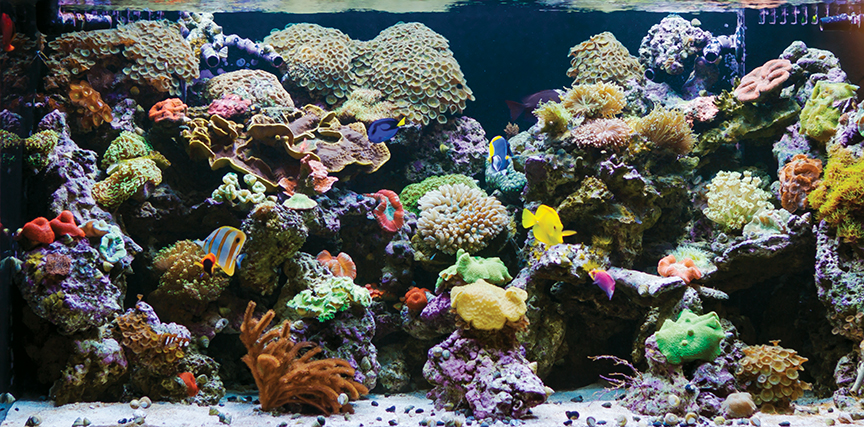
Photo courtesy of Infinity Aquarium Design.
“The popularity of public aquariums has grown over the years, giving people more opportunities to see exotic species, and everybody’s intrigued by fish,” says Raymer, who suggests the ability to maintain live corals and reefs accounts for the popularity of saltwater tanks. “The tanks are educational, soothing and relaxing to look at,” says the enthusiastic King of the hobby’s universal allure, adding, “The colors of fish are incredibly appealing and they all have their own personalities.”
Raymer reports that while it may scratch easier than glass, acrylic has become the state-of-the-art material for extravagant designs because of its ability to be bent and shaped. ATM’s design and installation process begins with an interview of the customer, whether a celebrity or suburban hobbyist. “First we find out what the client has in mind, then turn it over to our artist to create a rendering. Once we get the client’s approval, we go from there,” explains Raymer.
One of the company’s more outrageous projects, scheduled to appear on Tanked later this year, features the third appearance of comedian Tracy Morgan, whose pool house in posh Alpine, New Jersey, will be transformed into a massive 16,000-gallon shark tank designed by ATM. King explains sufficient space, structural soundness and a willingness to take care of the habitat (in addition to capital, of course) are the only limitations to ever-more-elaborate aquariums. ATM’s largest project was a $4.5 million aquarium for a megachurch in Texas, and an upcoming 70,000-gallon project in California will be the largest tank ever installed in a private residence.
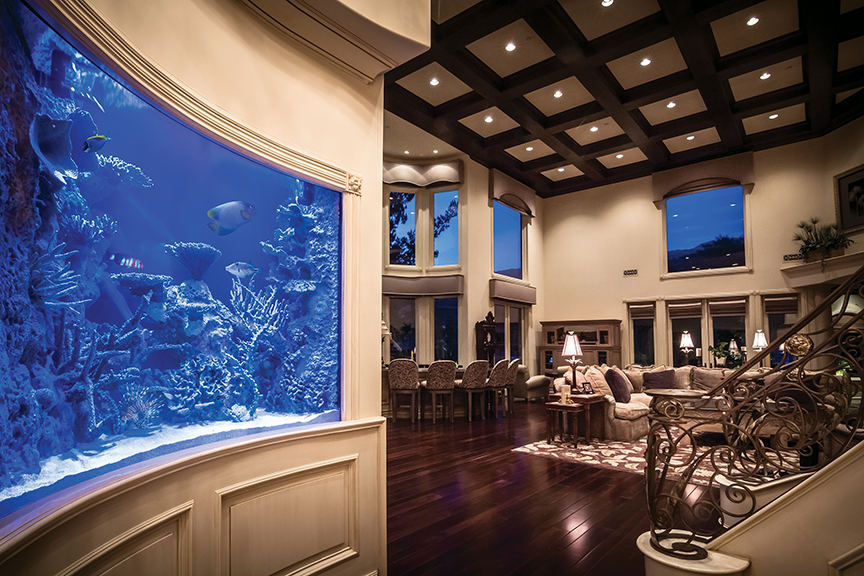
Photos courtesy of Infinity Aquarium Design.
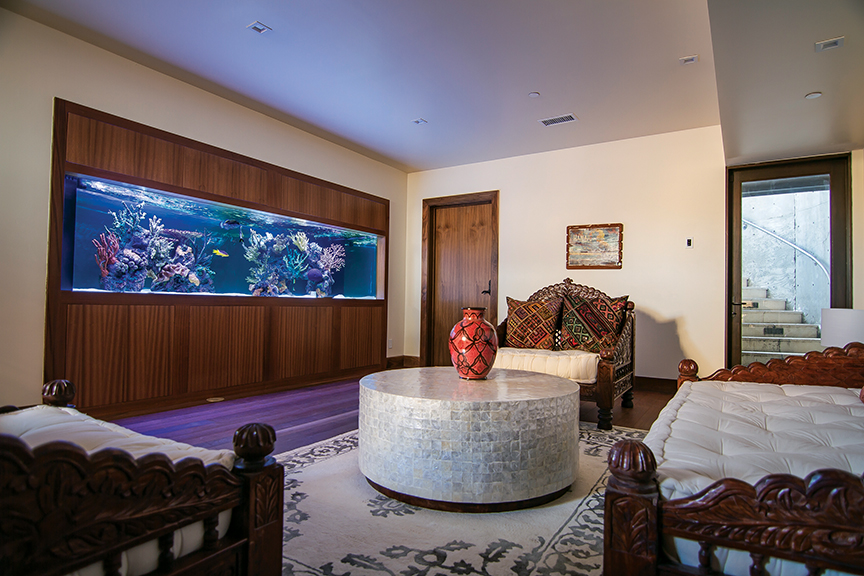
Jay Silber, a partner at Lakewood, New Jersey’s Aqua Creations — which serves metro New York City and beyond — reports affluent clients love the soothing effects of aquariums, while other owners are attracted to the feng shui benefits of having water and fish in a home. “One very wealthy client, he’s a big player whose home has a media room, disco room and everything you could ask for, tells me, ‘Jay, when I entertain, the first place everybody goes is to the tank!’”
Silber reports, “We build aquariums from $20,000 to $100,000, depending on how crazy you want to go, but we concentrate on creating a really interesting environment.” He insists the best installation practice is from the ground up, working with architects and builders to engineer the tank, accommodate proper plumbing and allocate sufficient space for an equipment room.
Compatibility, color and movement are the critical considerations when selecting the assortment of fish, according to Tiemens. “We try to create an underwater display that’s realistic and offers an environment that’s natural for the respective species, one in which every color of the rainbow is presented and where you’re constantly seeing different fish,” he says.
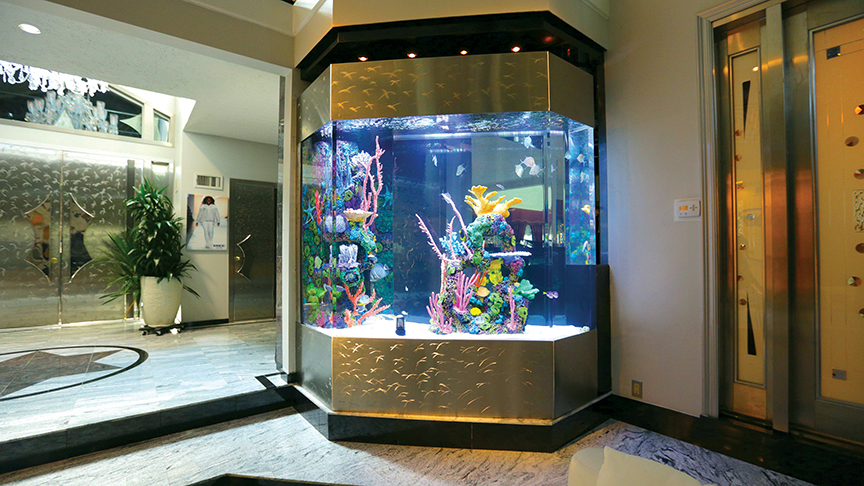
Photo courtesy of Life Aquariums.
Brett Raymer of ATM cautions homeowners, “You need to remember these are live animals … they’re pets, not just decoration, so you can’t just get it set up and forget about it.” He therefore advises clients to enter into a maintenance contract with a reputable company like ATM to ensure proper care. These days, advanced technology allows owners or aquarists to monitor water quality and manipulate pumps from anywhere in the world with the touch of a smartphone.
Acrylic Tank Manufacturing Las Vegas www.acrylicaquariums.com
Aqua Creations Lakewood, NJ www.aquacustomfishtanks.com
Reef Aquaria Design Coconut Creek, FL www.reefaquariadesign.com
Adam Hunter, Inc. Los Angeles www.adamhunterinc.com
Infinity Aquarium Design Los Angeles www.infinityaquariums.com

Staging your home could open the door for buyers and sellers in more ways than one. Home staging could mean decorating, furnishing and even painting an empty home that is on the market. Staging a home has been referred to as an art form and is usually used as a way to help sellers and buyers understand the possibilities that a home offers.
It is difficult for a buyer to imagine raising a family or spending a cozy holiday in a vacant space. Therefore, home staging allows buyers to imagine what their home could be. Additionally, if a room is staged well that can help a seller pitch the idea of the space as a home. The impersonal feel of an empty house can be quelled by the right coat of paint, properly arranged furniture, and other final touches, such as decor.
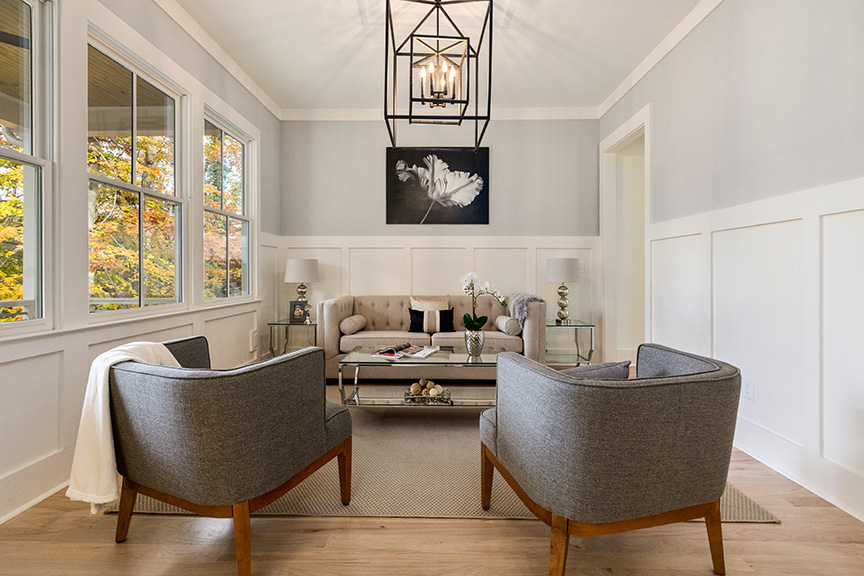
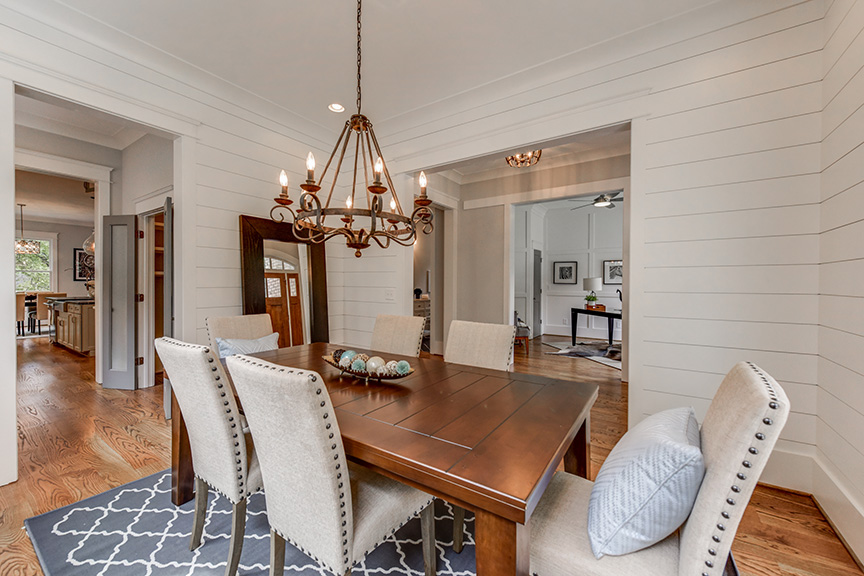
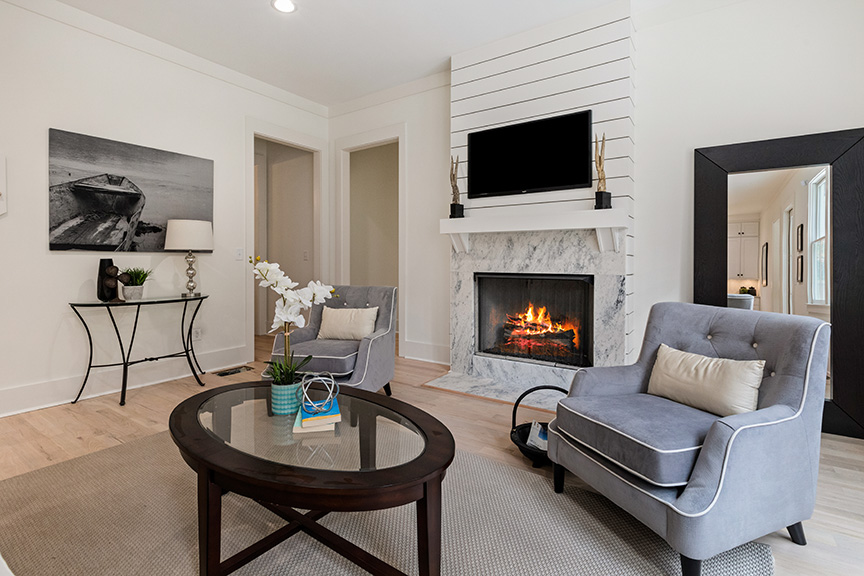

1. Organize and avoid clutter. This will make it easier for a potential buyer to see themselves living in the home.
2. Think fresh and light. Keep blinds and curtains open to let in as much natural light as possible. Also, if any of the rooms in the home are painted a deep exotic or bright neon color then it is best to neutralize each room by having walls painted a nice warm color.
3. Update and repair. Take note of any noticeable or large fixes that need to be made and take care of them early.
4. Don’t forget the exterior. The first impression a potential home buyer will have of a house will be of the exterior, so nice curb appeal is important.
5. The price is worth it. The average cost of a complete staging project is usually much less than your first price reduction. Statistically, homes that have been properly prepared for the market sell before a price reduction is needed.
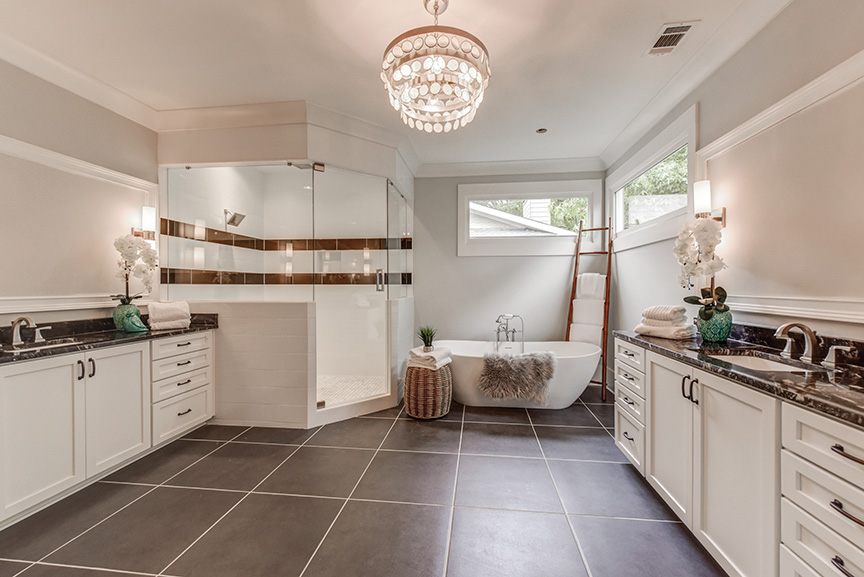
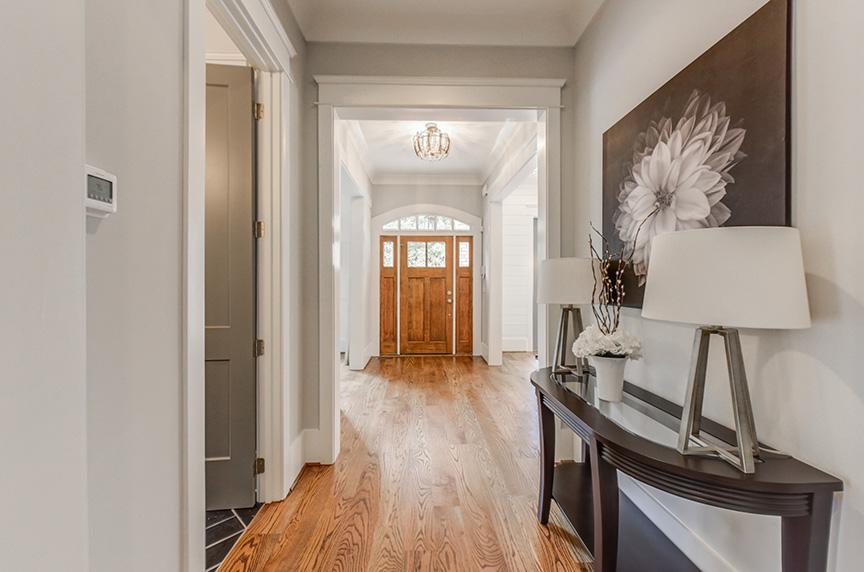
6. Decorating and staging are almost complete opposites. Decorating involves putting the existing homeowners’ tastes and styles into the house, making it personal. Staging involves taking one’s personality out of the house, so the decor is neutral and appealing to the broadest range of potential home buyers.
7. It is best to have your house staged first and then have it listed. Think of the importance of first impressions. The greatest buzz about a house is generated when it is first listed.
8. Although new to the television circuit, home staging has actually been around since the 1970s. In some areas of the country, home staging is as common as open houses. The central states are starting to recognize the value of a staged home, not because it is trendy, but because it works!
9. Do emphasize the upscale and custom features of a home with staging, but DON’T overdo it. Keep it clean lines and simple.
10. Don’t place furnishings or decor that block light or views. Do stage the home with tasteful furnishings and make it easy for prospective buyers to walk straight to amazing ocean, mountain, or island views.
Photos courtesy of Krisztina Bell, No Vacancy Home Staging
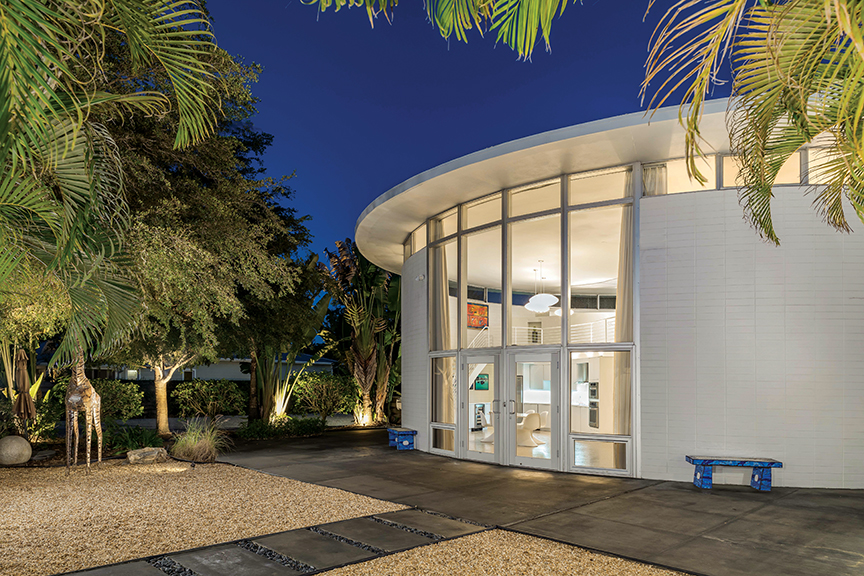
Photo by Rich Montalbano
Mid-Century Modern design came onto the scene before color television. But rather than appearing antiquated today, it inspires contemporary designers and homebuyers.
The popularity of Mid-Century Modern design continues to accelerate, confirmation that the masters who introduced the look in the ’40s and ’50s were visionary innovators. Decades later, the work of those architects, interior designers and furniture makers still appears fresh, and current expressions of modernism invariably build on the mid-century movement.
Sam Lubell, a leading authority on Mid-Century Modern design, whose books include Mid-Century Modern Travel Guide: West Coast USA and California Captured, believes the genre’s enduring appeal can be attributed to simple, elegant aesthetics, the success in reducing architecture to its most basic elements, and nostalgia. “Mid-Century Modern is a blend of technology, simplicity and a style that’s very ‘cool,’ for lack of a better word, enhancing people’s appreciation of it,” says Lubell. The writer suggests that vintage photographs from the era reveal how truly revolutionary Mid-Century Modern architects were. “Cars in the photos appear to have nothing to do with the houses. It’s hard to describe just how radical and ahead of their time they were,” he observes.
In the U.S., passions for Mid-Century Modern residential design burned first and most intensely in and around Los Angeles, responding to trends already underway in Europe, but not so elegantly applied to single-family residences. In a city where challenging established convention was not discouraged, disciples of Frank Lloyd Wright — pioneering architects Rudolph Schindler, Richard Neutra and John Lautner — transformed residential aesthetics and attitudes.
The genesis of Mid-Century Modernism may have occurred in the City of Angels, but today’s epicenter of the style is Palm Springs, the desert resort city 100 miles east of L.A. Practically the entire municipality is a living museum of mid-century design, and that signature aesthetic has become as much a tourist attraction as Palm Springs’ legendary golf, tennis and shopping.
Every February, the community celebrates its architectural legacy with Modernism Week, where architects, designers and collectors from around the world draw inspiration from home tours, seminars, film screenings, and receptions in famous settings that include not just residences, but Mid-Century Modern hotels and restaurants.
Lisa Vossler Smith, who served as a volunteer for Modernism Week when it debuted in 2006 and was named executive director five years ago, reports the 2018 edition drew 126,000 people from 15 countries, more than double the attendance in 2015. She has observed an ever-increasing commitment by local residents to embrace their city’s architectural heritage and believes Modernism Week has profoundly influenced preservation efforts in Palm Springs and beyond. “Our goal is to educate visitors, so they can take back what they’ve learned to their own communities,” says Vossler Smith, who actively supports similar events across the country.
Vossler Smith insists the fascination with Mid-Century Modern design is multigenerational, while conceding popular shows like Mad Men have contributed to the genre’s hip factor. “Clearly, there’s a sense of nostalgia for the baby boomer generation, but we find younger homebuyers are also attracted by the more simplistic, minimalistic lifestyle offered by these homes,” she says. “We’re now starting to explore new building projects informed by the mid-century design period,” says Modernism Week’s executive director, noting the influence of trailblazers such as Neutra and Schindler is evident in contemporary modern architecture.
While Vossler Smith admits Mid-Century Modernism is ideally suited to Southern California, she reports outstanding examples from the era are plentiful in places like Denver, Phoenix and Chicago. In Denver, real estate broker Adrian Kinney is a local expert on Mid-Century Modern homes, and his personal renovation of a Cliff May-designed residence reinforced his enthusiasm for quality design from that period. Finding some modernism too austere, Kinney was delighted to discover the warmth that many mid-century architects, like May, brought to their craft. “The more I learned, the more I wanted to educate everyone about what this modernism thing was all about!,” says the real estate professional.
“Buyers of Mid-Century Modern properties range from boomers to millennials, all wanting something different, functional and livable, with a sense of character,” says Kinney, who co-founded Denver’s own Modernism Show to draw attention to the Mile High City’s architectural assets. “After attending Palm Springs’ Modernism Week many times, I knew Denver needed to have one,” he says. Identifying more than 6,000 Mid-Century Modern homes in metro Denver, Kinney declares, “I want to showcase these to the world.”
Best known for its sugar-white beaches, the Gulf Coast city of Sarasota, Florida, shares a rich Mid-Century Modern heritage. Local broker Martie Lieberman of Premier Sotheby’s International Realty is recognized by both the real estate and architectural communities as an authority on the “Sarasota School of Architecture.”
Lieberman, who co-founded the Sarasota Architectural Foundation, is passionate about Mid-Century Modern homes and has made the sale of those properties her specialty. Observing that many houses from the Sarasota School elicit a sense of delight at first glance, she suggests the interiors are equally impactful. “You’ll see some of the most sophisticated uses of space and light, which most people have never experienced,” she insists.
Architects like Paul Rudolph and Victor Lundy created low-slung, glass-ensconced homes that were a dramatic departure from the prevailing Mediterranean style, explains Lieberman, noting they attracted idealistic young designers to Sarasota in the ’50s and ’60s. “They thought they would change the world with their new ideas, new materials and a new architecture,” she says. According to the niche broker, newcomers to Sarasota are quickly won over by the community’s architectural legacy, and Lieberman reports that significant Mid-Century Modern homes can command premiums of 15 to 35 percent.
A prefabricated home designed by legendary Mid-Century architect Cliff May, erected in 1955 in Denver.
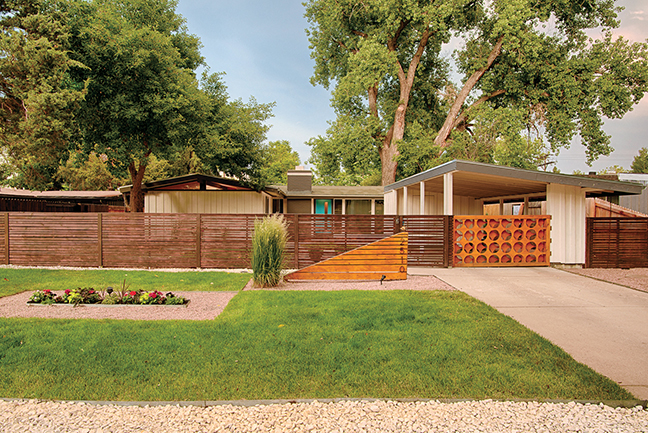
Real estate broker Adrian Kinney restored this 1955 Cliff May property in Denver, fueling his passion for mid-century design.
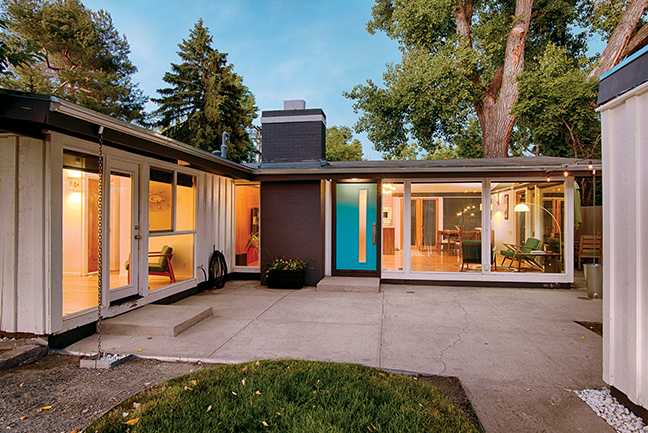
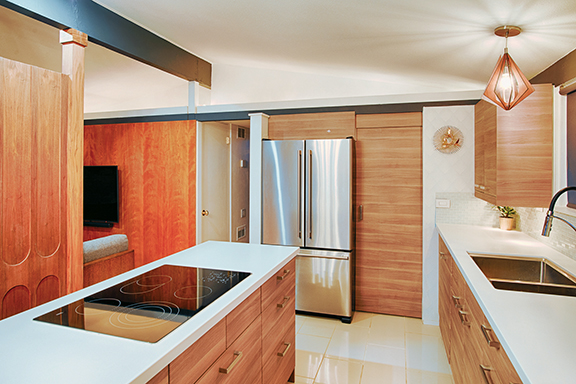
Photos by Atom Stevens
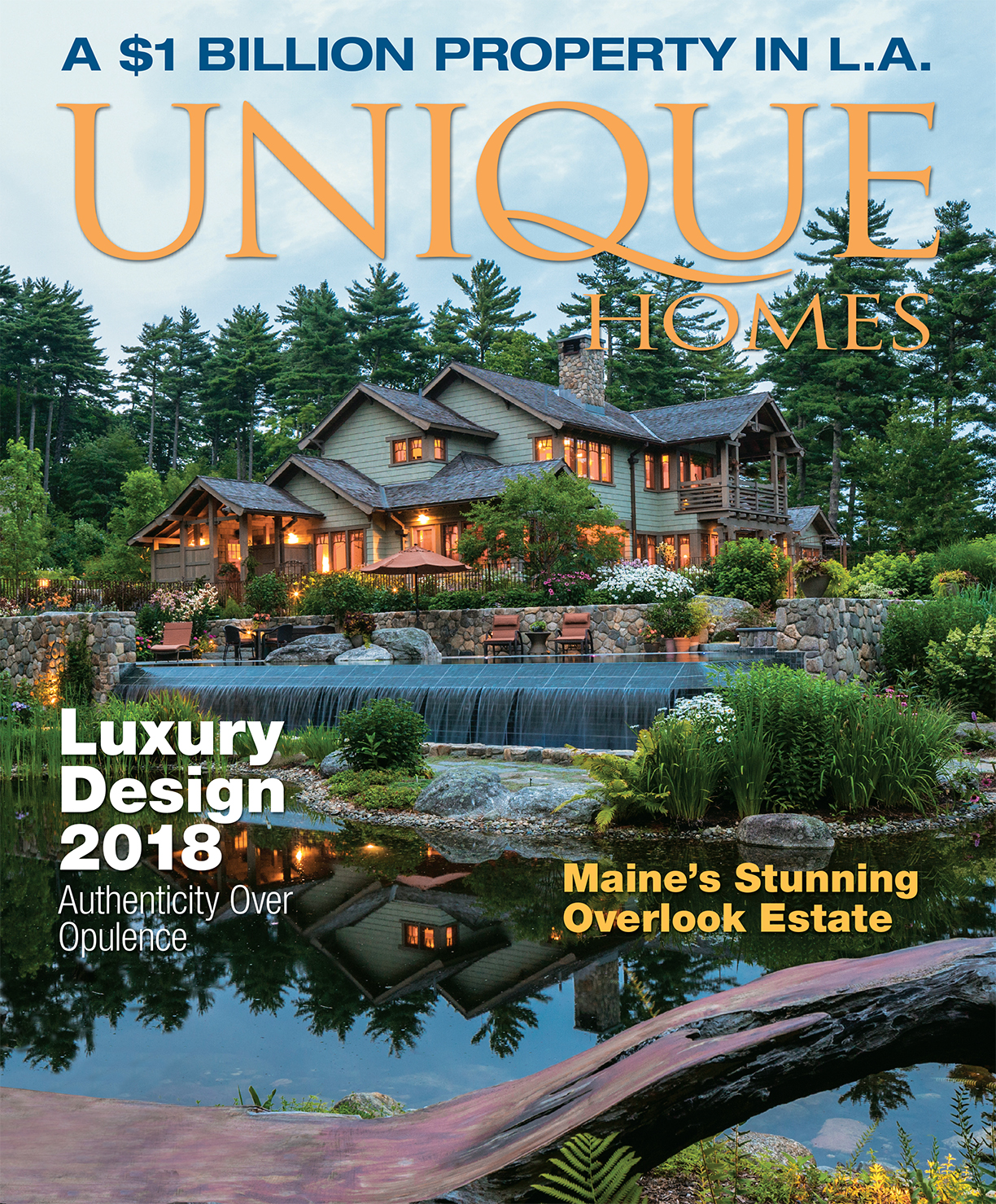
Vintage pieces add character and depth that cannot be imitated by modern mass-produced furniture. Embracing vintage trends in your home does not mean that you must abandon contemporary designs, however.
Many antiques fit well with today’s straight lines, bold colors and attention to detail. Whether you’re looking to make a statement with an ornate, attention-grabbing item or desire a subtle quaint aesthetic, vintage pieces can give a room personality and complexity unmatched by what can be found in the average furniture store.
If you are unsure how to go about incorporating timeless vintage pieces to your home’s decor, here are five tables with vintage charm that will give your home an extra dose of elegance:
Set of Four Vintage Rosewood & Inlaid Pearl Chinese Nesting Tables
$875
These handcrafted tables are made from solid rosewood and are engraved with genuine mother of pearl. You can store them together as a set or in separate rooms to create a cohesive aesthetic throughout your home.
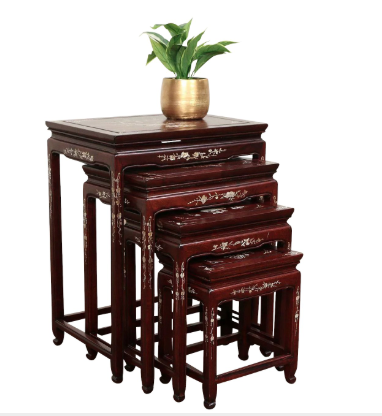
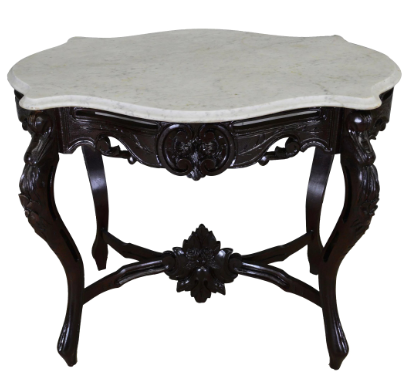
Victorian Marble Top Turtle Top Carved Table
$628
This sleek rococo-style table dates back to the 1890s. The simple white and gray grained marble top contrasts the carefully carved solid black mahogany base, perfect for the minimalist homeowner seeking to diversify their decor.
French Louis XV Style Nightstand
$895
Bring vintage trends into your bedroom with this mid 20th century nightstand, which features a serpentine shaped faux-marble top. This charming piece is a perfect fit for vintage enthusiasts looking to add a touch of femininity to their collection.
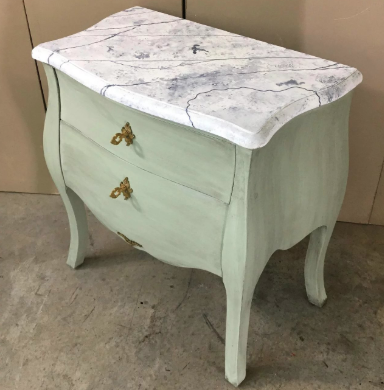
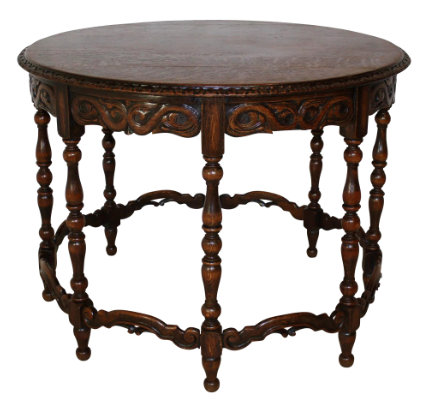
Round Oak Table
$995
Approximately 118 years old, this table features opposing scroll carvings that come together to form a floral design reminiscent of acanthus leaves. An ideal coffee table, this piece is stylishly supported by eight turned legs with ball feet.
Antique Chinese Hand Carved Rosewood Table with Marble Top
$1,995
This side table is between 100 and 150 years old, and features breathtaking carvings that make this elegant stand perfect for an upscale living room, library or bedroom.
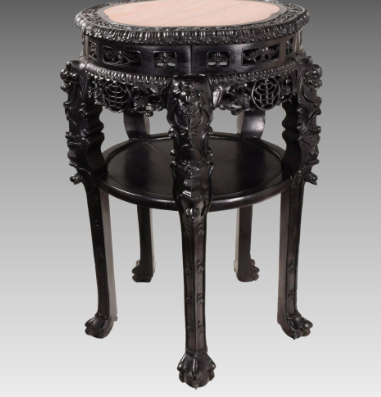
Photos courtesy of www.rubylane.com.
Centerpieces are an additional detail that brings an overall sense of completion to a table or room.
As the holiday season approaches, menus, decor, and more are on everyone’s mind. This year, if you’re hosting a small army or having an intimate gathering, don’t forget your centerpiece. Artemest offers a world of luxury craftsmanship, and that includes a variety of centerpieces that will adorn holiday tables this year and more to come.
- Be Bold With Colors ($310)
Part of the Dogale collection and made from mouth-blown glass and silver plating, the Rosso Cardinale Centerpiece is the perfect pop of color. The Italian-crafted piece offers a sleek and elegant look that comes from the combination of shimmering glass and hand-brushed silver plating.
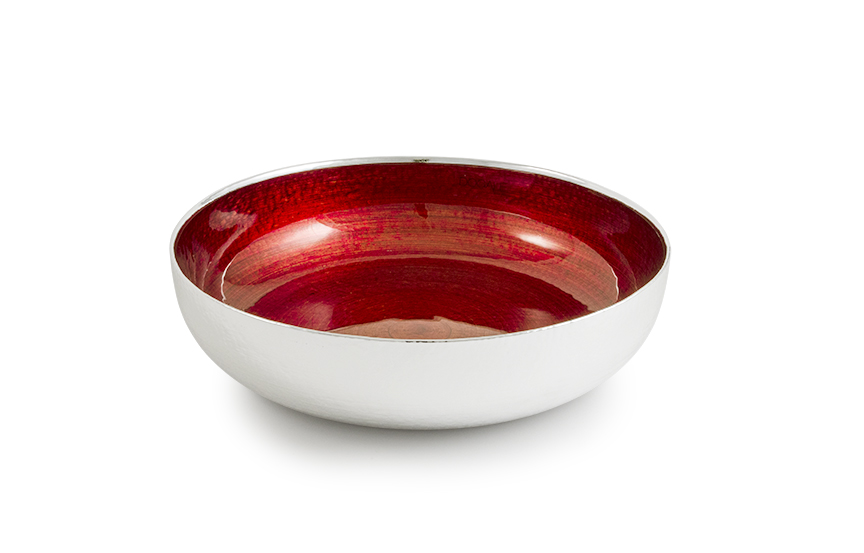
- Embrace Different ($730)
Designed by Gaetano Pesce in 1995 as part of the Fish Design collection, the Big Collina Extracolor Blue XL Centerpiece will stand out on any table. This large, blue bowl is fun and opens the door for creativity. Pile the bowl with a mountain of colorful fruit or gourds this fall or fill it with flowers for a beautiful centerpiece.
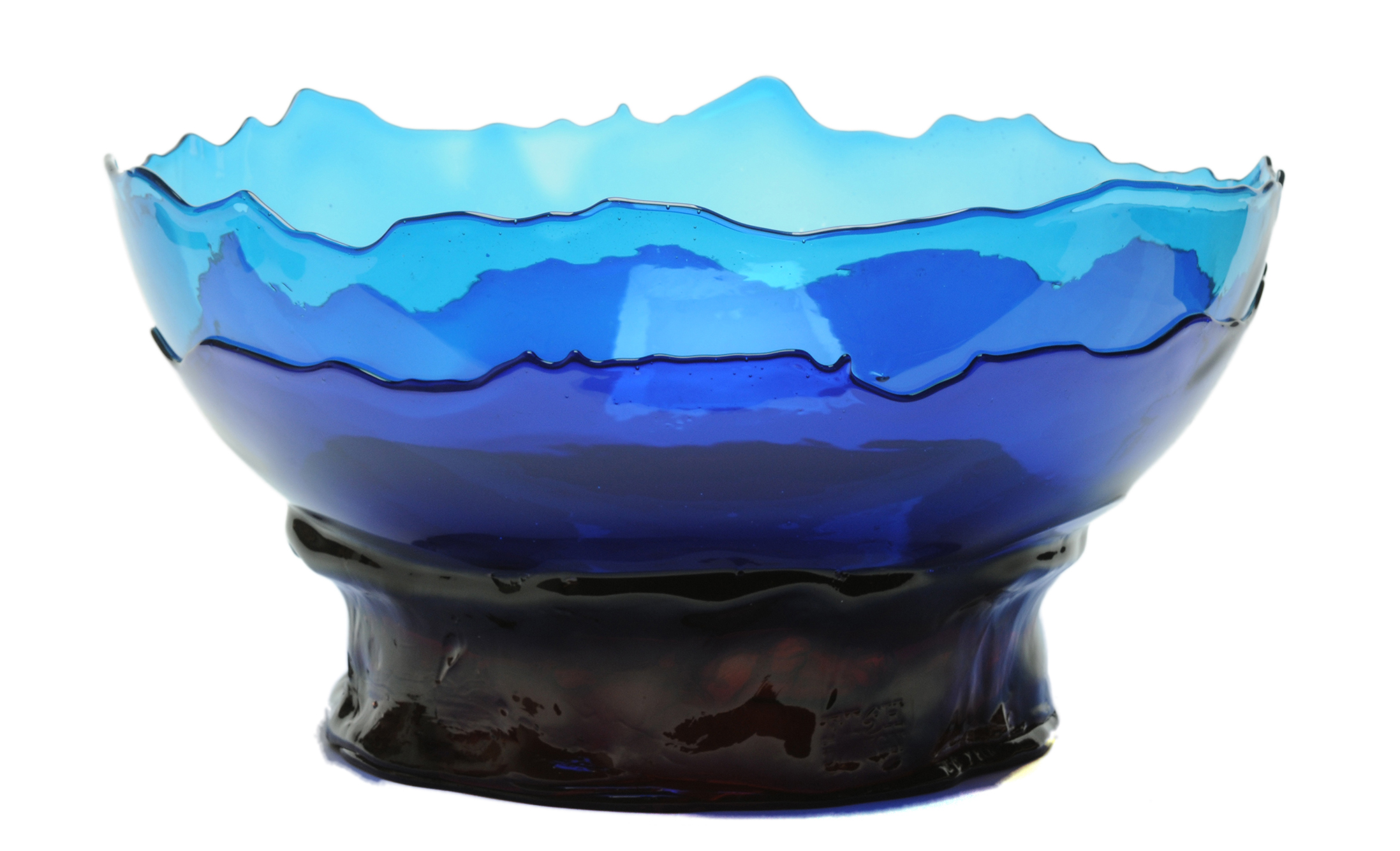
3. Start a Conversation ($3,770)
Designed by Afra and Tobia Scarpa, the Mania Bowl, is in the shape of two open hands. The bowl is made of 999/1000 pure silver and serves as a sculpture or a bowl. This kind of centerpiece is sure to start a conversation about art and decor as you sit down and enjoy your meal.
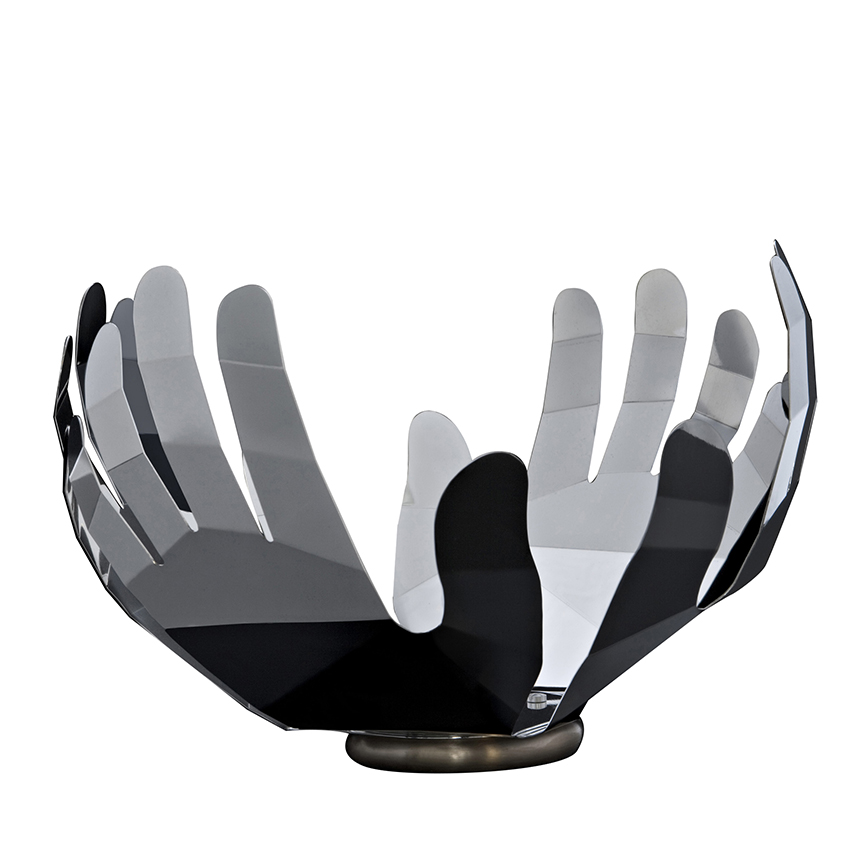
4. Stay Classic ($1,900)
The Intreccio Centerpiece by Adolfo Natalini is a call to ancient times. The use of Carrara marble, Green Alpi marble, Rosa Portogallo marble and the choice of colors are reminiscent of earlier and simpler times. The plate has a timeless aesthetic that will accent a variety of rooms.
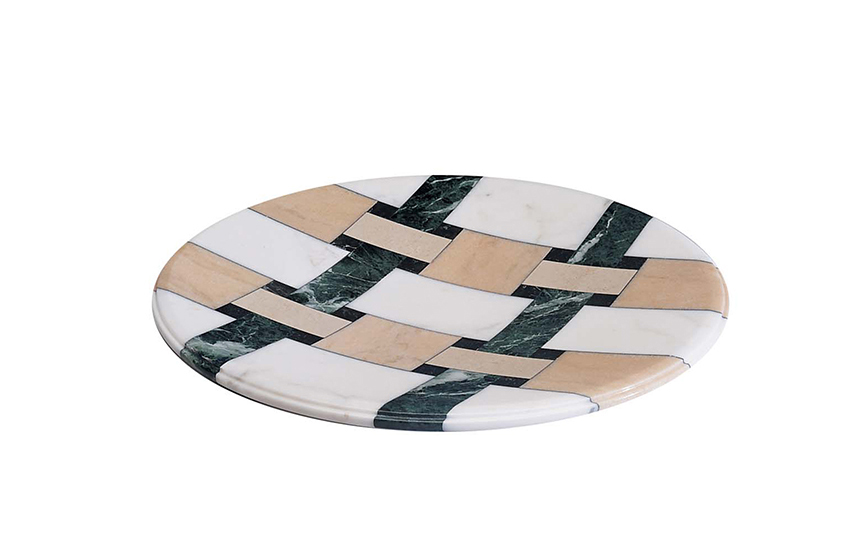
- Modern Is Magic ($750)
Add a striking modern touch to your table with the Cartoccio Bowl by Afra and Tobia Scarpa. Don’t shy away from the pointed corners, they can be softened by the addition of colorful flowers and fruit. The natural shades of fruit will glow surrounded by sleek, reflective silver. Crafted from 999/1000 pure silver, the bowl is undeniably modern.

Photos courtesy of Artemest
Shop on www.artemest.com
Murals that are making a bold impact on the world of interior design with fresh prints and inspiring colors.

Historically, wallpaper was a long-term decor commitment; it was difficult to remove. The process involved steam and scrapping, which could be a headache. However, wallpaper and wall murals have been revolutionized by technology and easier application over the years. With continuing popularity, Sandberg Wallpaper has released several prints that are bound to stun.
Some brands have introduced peel and stick applications while most other types can be removed without leaving glue or residue behind. These new methods, better tools, and unforgettable designs have made wallpaper and wall murals something that — ironically — you’ll want to keep around.
Previously, personalized designs, textured prints, and bold colors were not as readily accessible as they are with technology today. A wall-sized bouquet of flowers is a far cry from a repeating floral pattern that typically comes to mind when thinking of wallpaper.
Sandberg Wallpaper offers a plethora of options when it comes to unique designs and unforgettable murals.
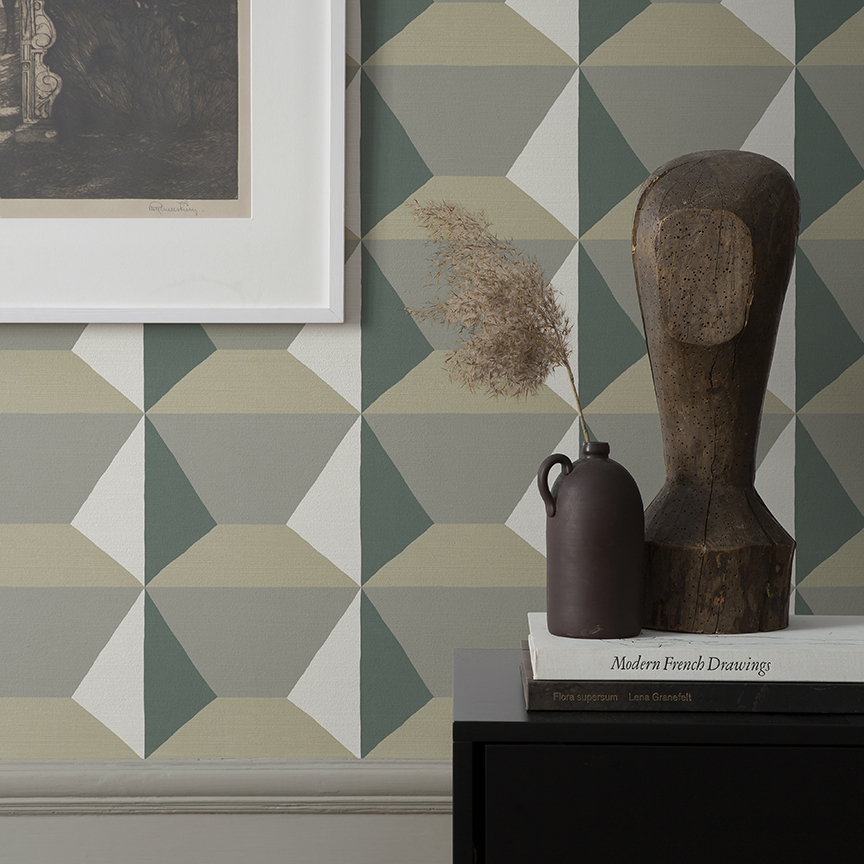
Ilse, from OAS collection, is a wall mural that is a soft textile with comfortable and warm tones from Studio Sandberg.
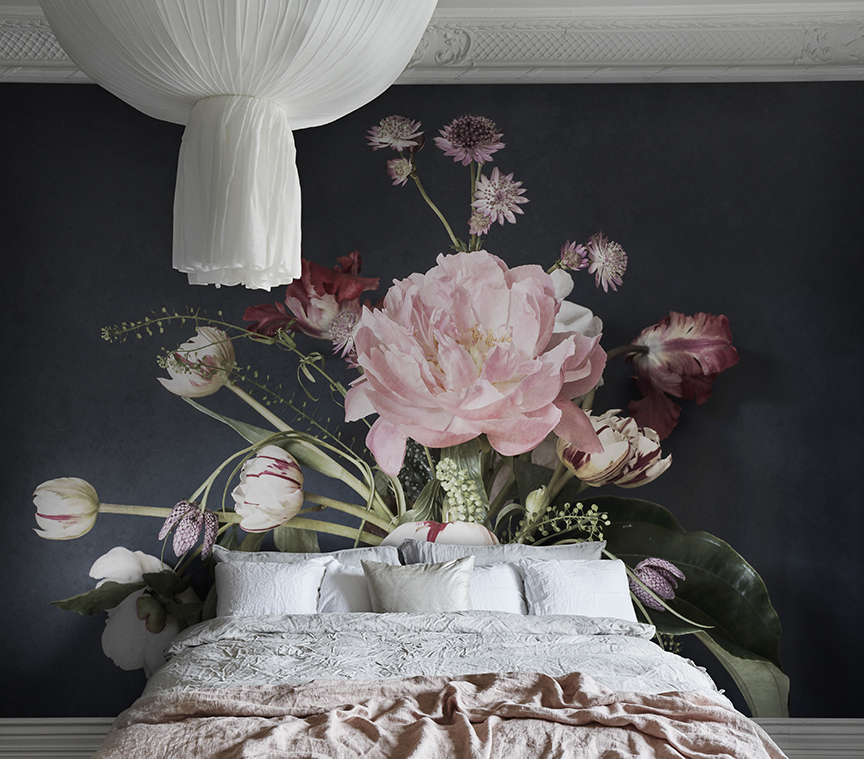
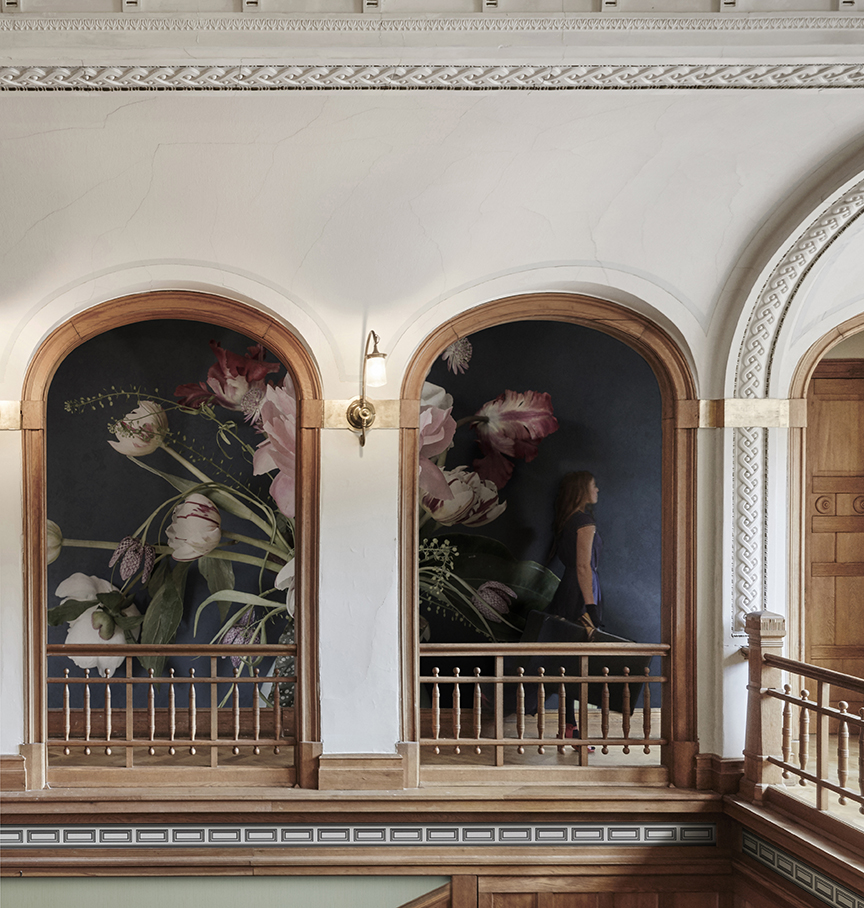
Julie from the L’Hotel collection and designed by Sara Bergqvist is a wall mural that poses an impressive flower display. The massive flowers in the Julie bouquet are in that perfect, delicate stage just before they finish blooming.
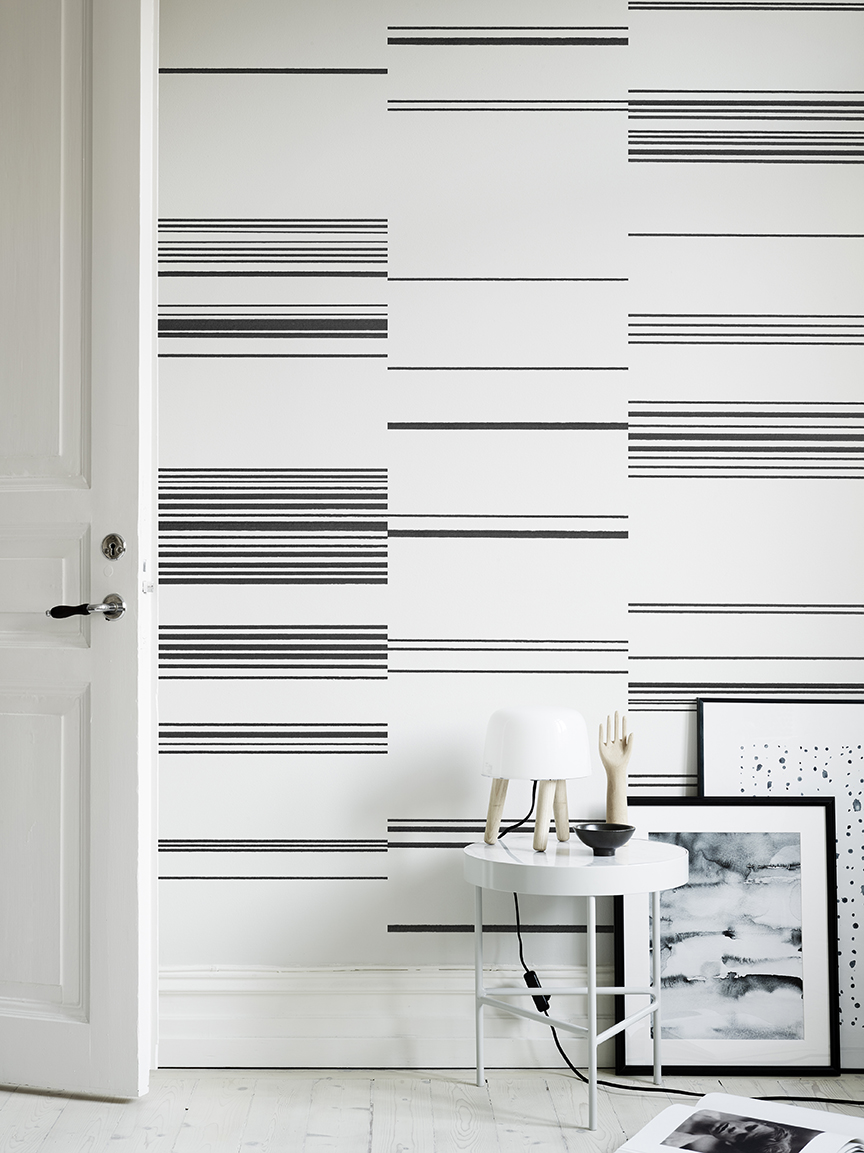
Kallio from Rand Scandinavian Stripes collection is a wall mural that is full of contrasts and was inspired by stark rocks against a wide-open horizon. The mesmerizing print appears straight and confined but is free and inspiring. Kallio was designed by Johanna Vestlin.
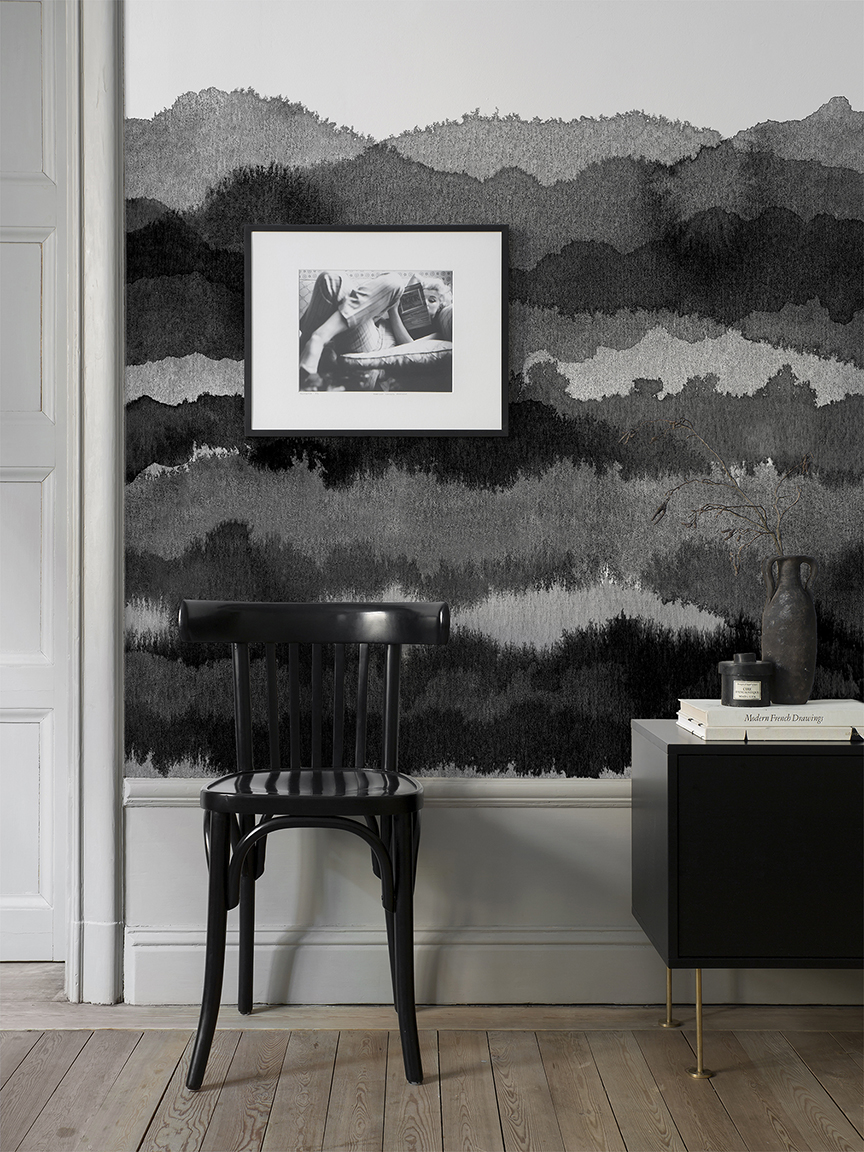
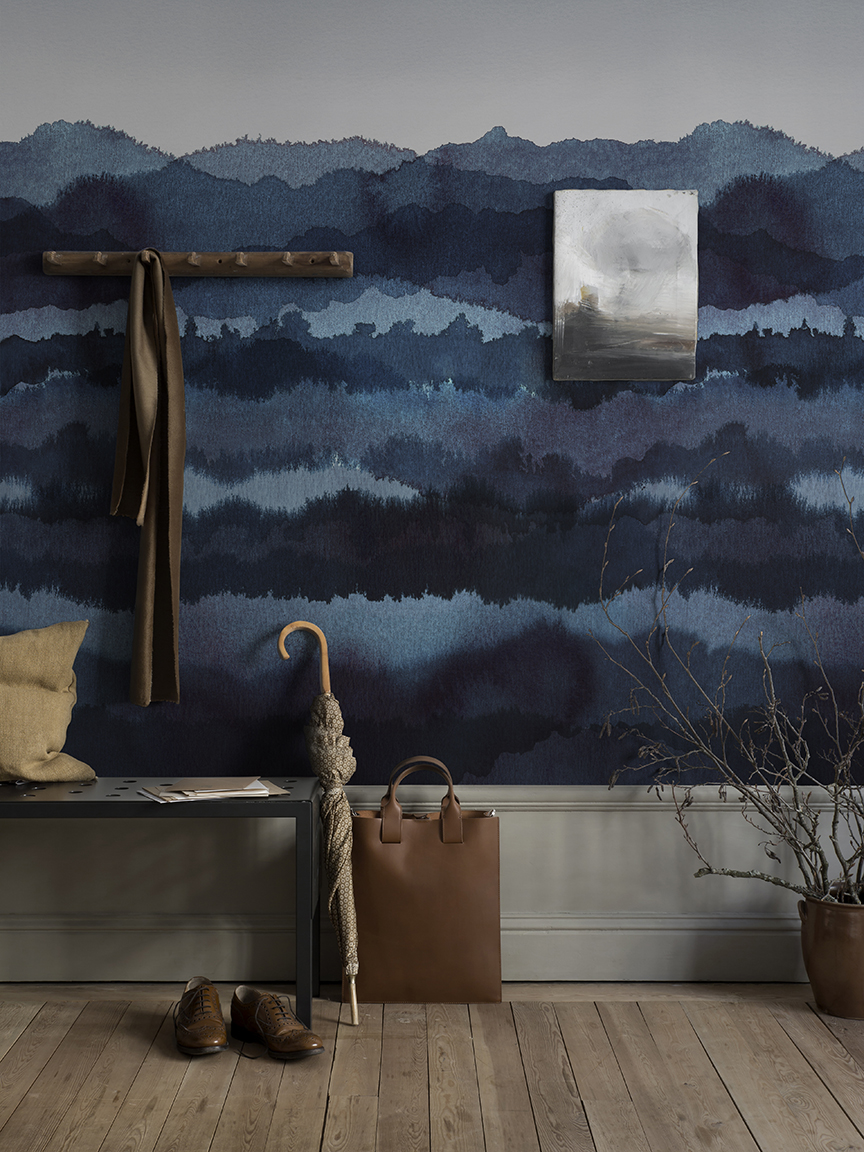
Midnatt from the OAS collection is deep and dramatic with dark any mysterious tones, and a lulling and dreamlike horizon. This is a wall mural that creates a canvas across several strips of wallpaper and was designed by Karolina Kroon.
Photos courtesy of www.sandbergwallpaper.com
After choosing the perfect dining table, preparing an unforgettable meal, and gathering your guests, don’t forget to select a set of dinnerware that will showcase your style.
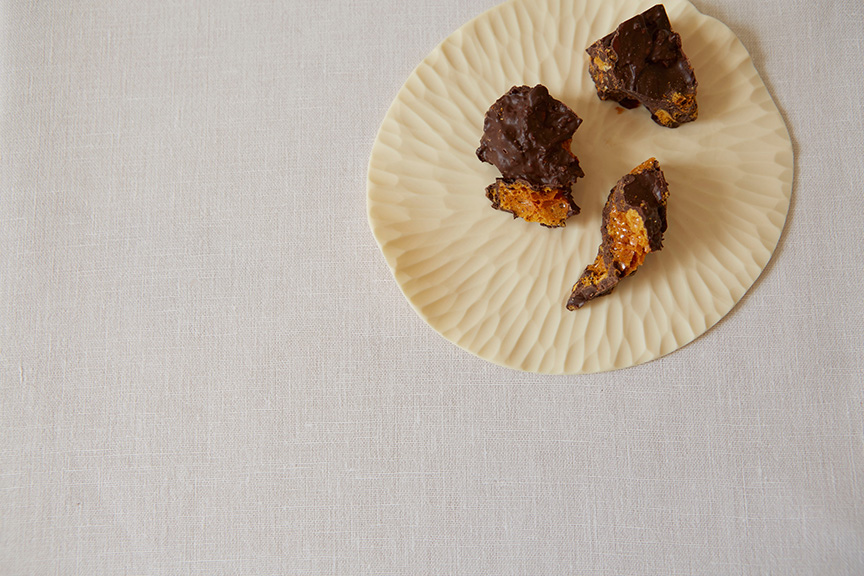
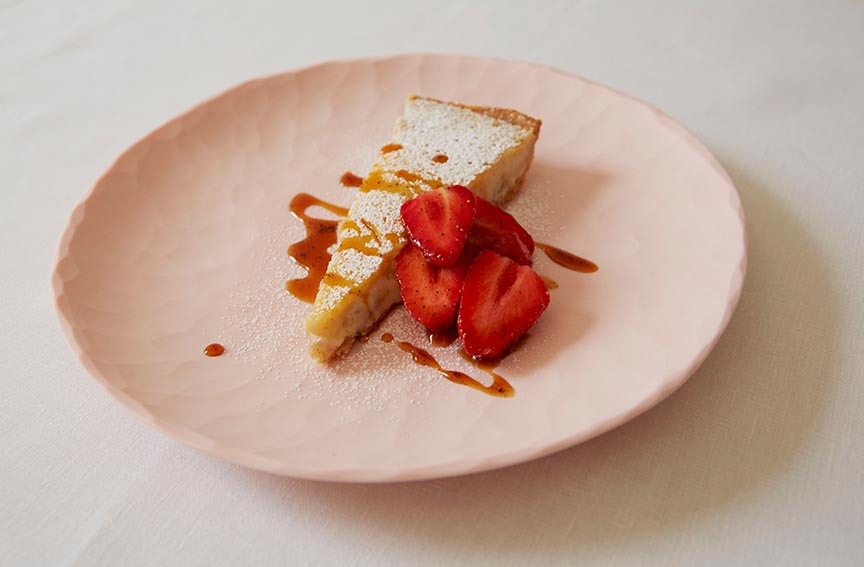
The way we display our food has become a delicate form of art, from intricately drizzled sauces to the dishes on which they are served. Cristina Vezzini and Stan Chen are making elegance easy with their stunning dinnerware collection. Vezzini & Chen is a combination of hand-carved ceramics and hand-blown glass, which gives each piece a unique touch.
Vezzini, originally from Italy, and Chen, who is from Taiwan, met while attending The Royal College of Art and continued working together after graduation in their London studio. Although the two specialize in different materials and techniques, Chen being the skilled glassblower and Vezzini focusing on handcrafted ceramics, the team is a cohesive unit, which shines through in their work.
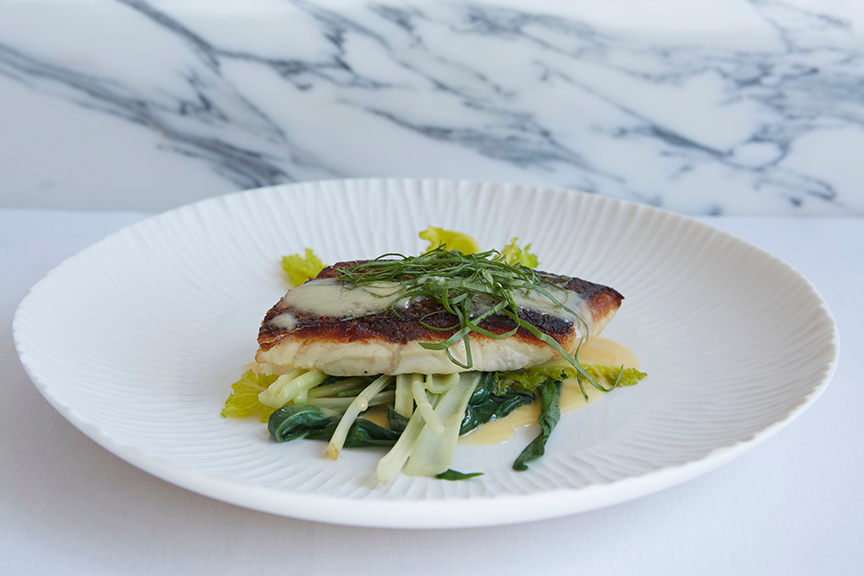
It is unlikely that you’ll find another set like Vezzini & Chen’s because each and every piece is handmade and carefully constructed by the duo. Their broad range of inspiration also adds an exclusive aspect to each set. Inspiration from nature, such as fire and water elements, comes through in their designs and pairs nicely with the natural materials that they mold.
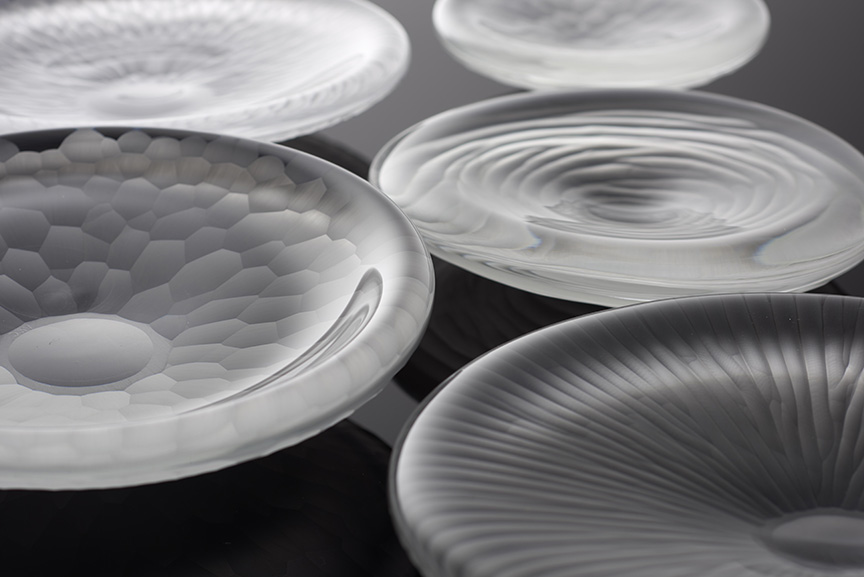
Vezzini & Chen’s Hexa Plates and Hexa Bowls are inspired by the idea of looking through water, and the layered, multi-faceted image that appears on the other side. The bowls and plates are available in four signature textures.
Just a glimpse of Vezzin & Chen’s work include these other remarkable collections. The Hexa Wine Glasses are also available in four textures, but each individual glass is as unique as a snowflake.The Horizon Wine Glasses are delicate, hand engraved, and unforgettable. Buyers will certainly want a set of their own, but the hand-carved ceramic plates are part of a limited edition for the Spring Restaurant in London.
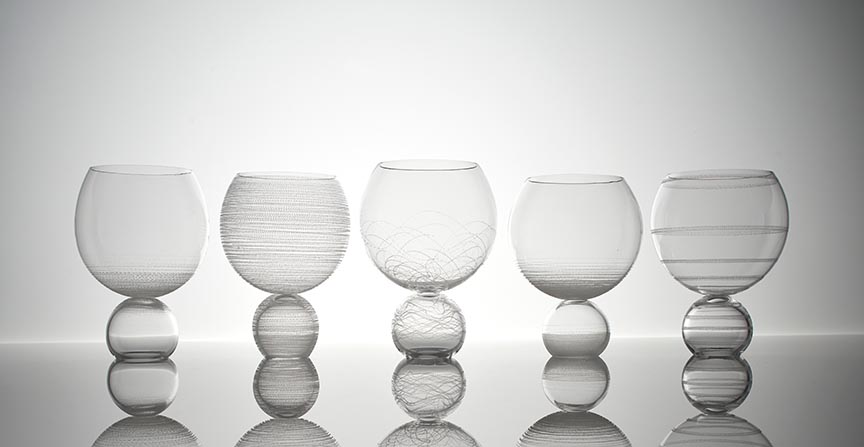
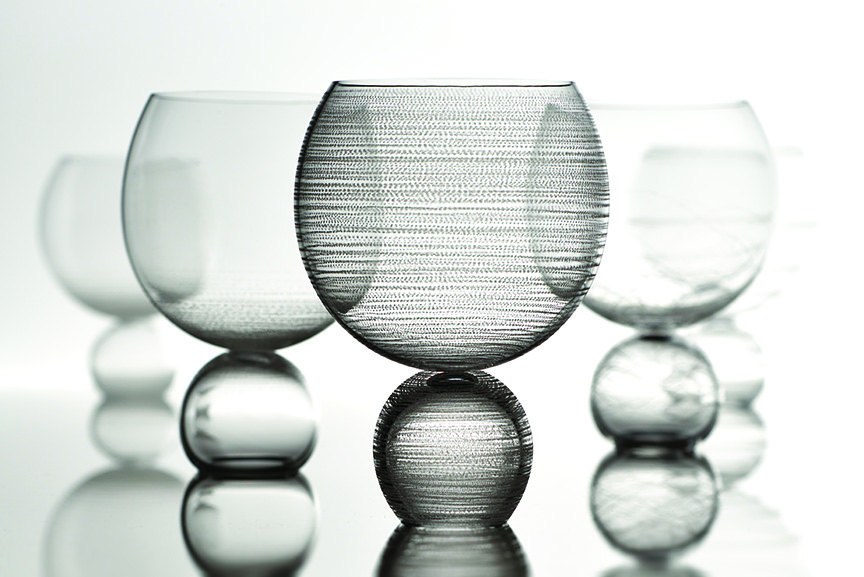
Light, geometry, texture, and repetition are also a large part of Vezzini’s designs, which contrasts Chen’s smooth, flawless glass creations nicely. The two designers use these inspirations to work together and bring their pieces to life. Vezzini & Chen’s dinnerware collections will stand out on any table!
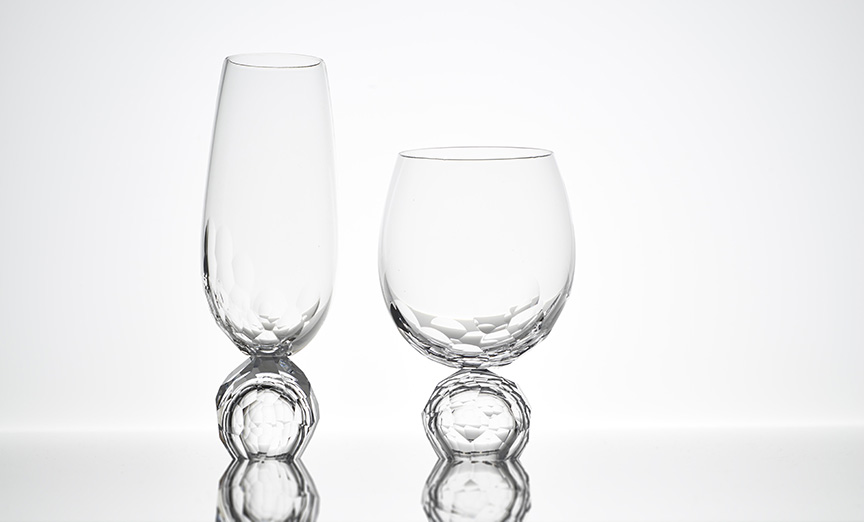
Photos courtesy of Vezzini & Chen











